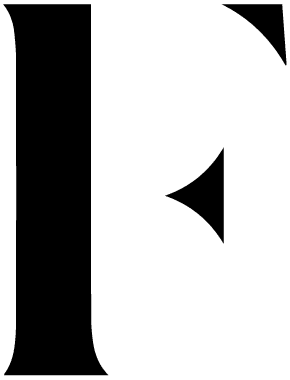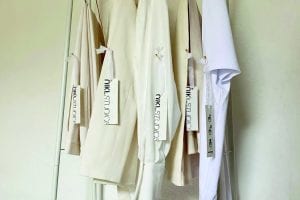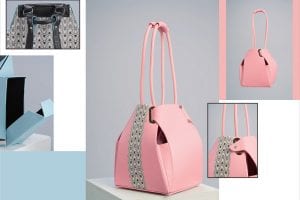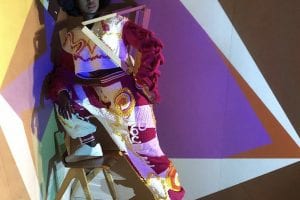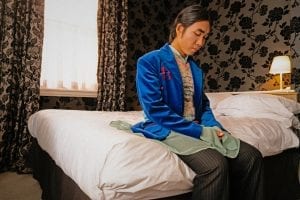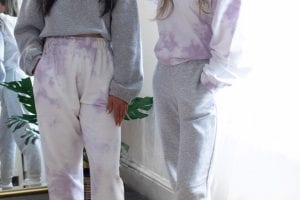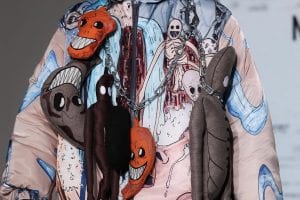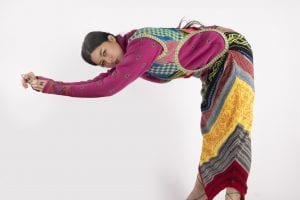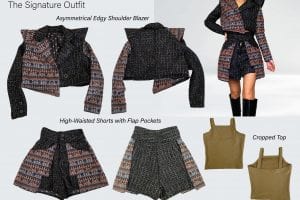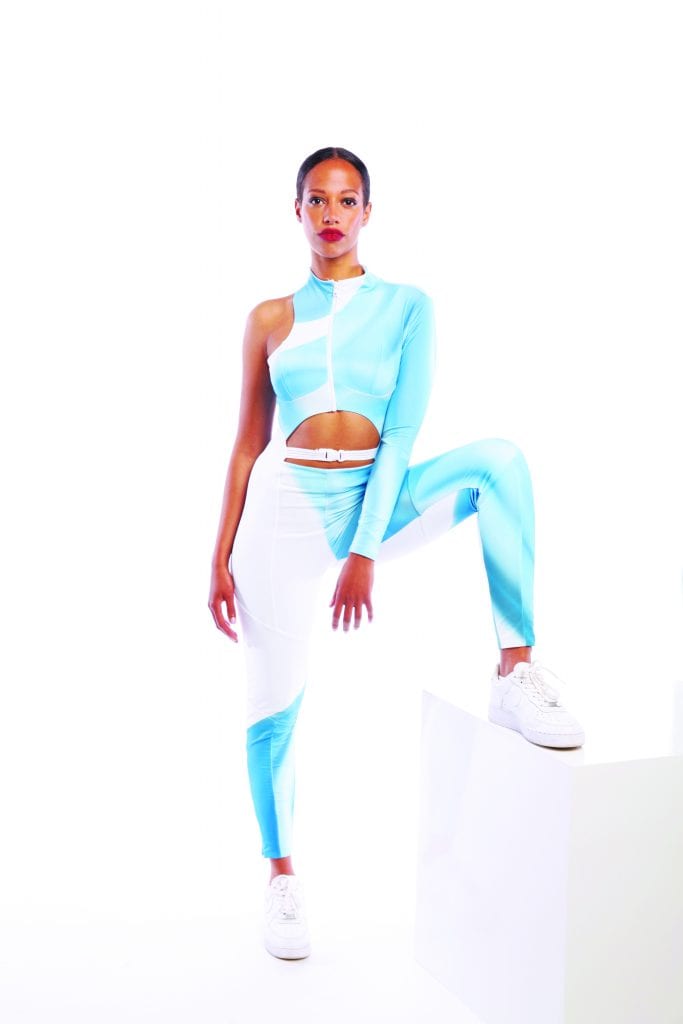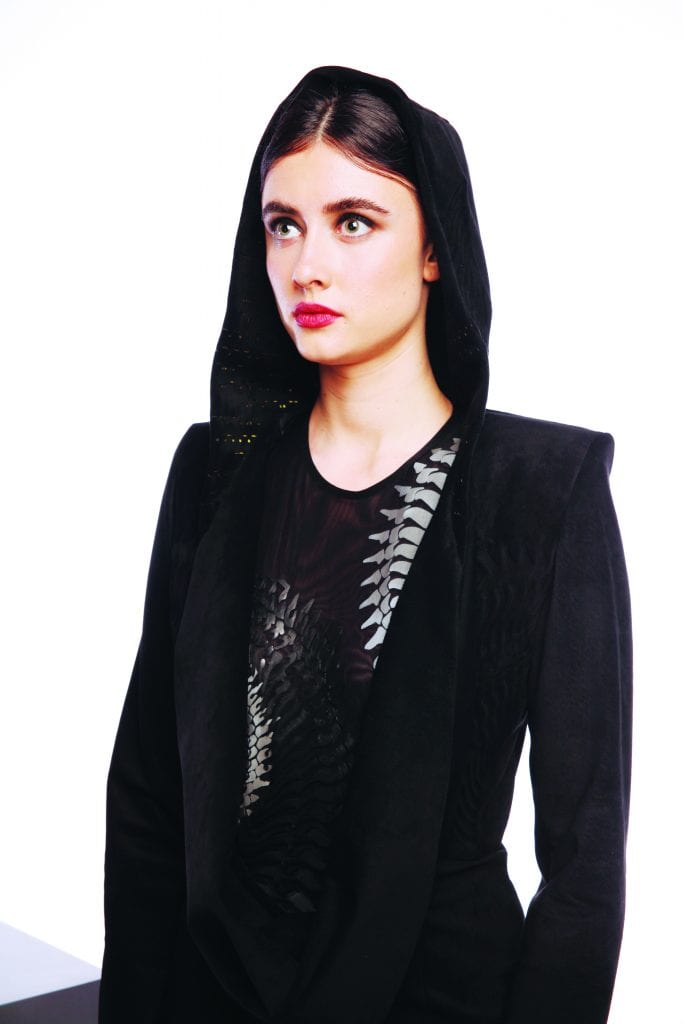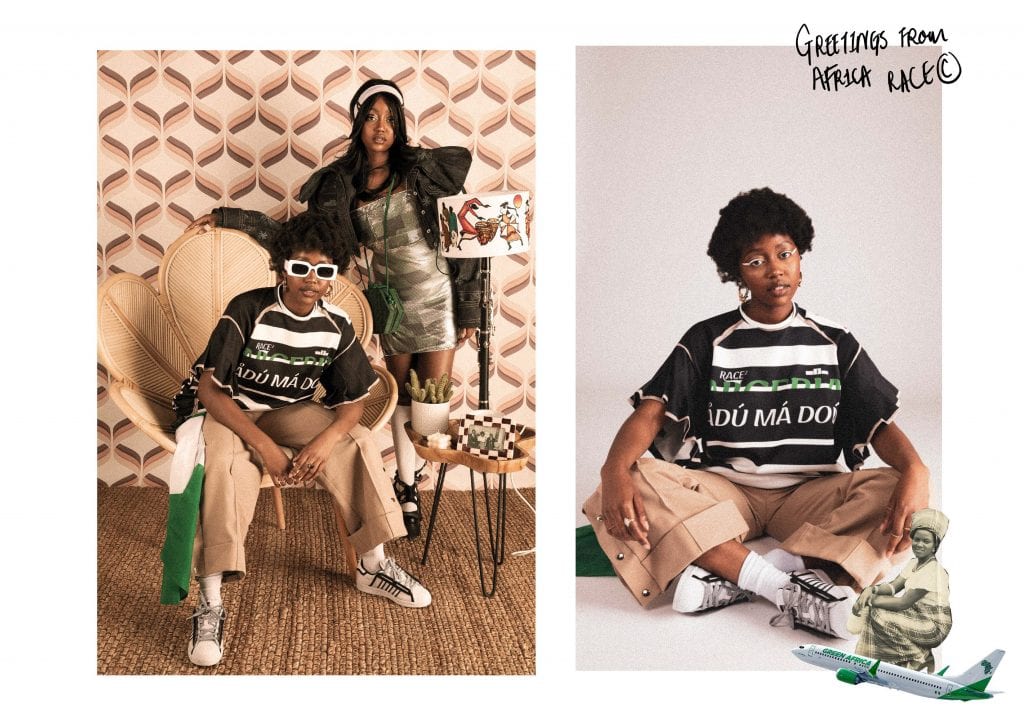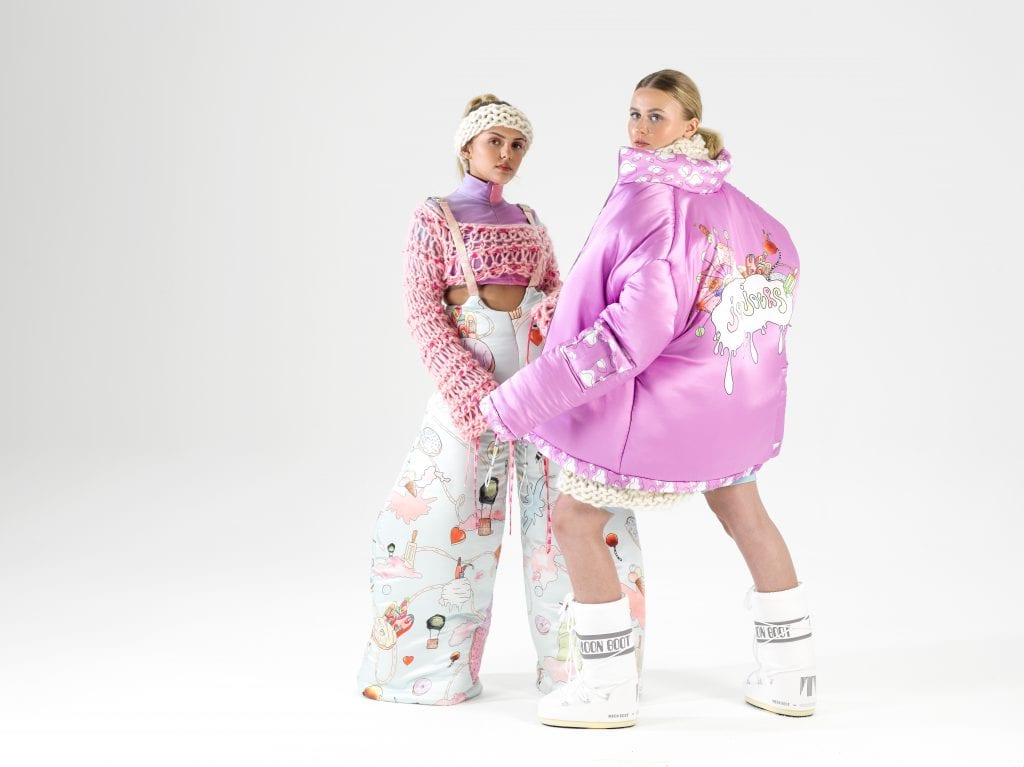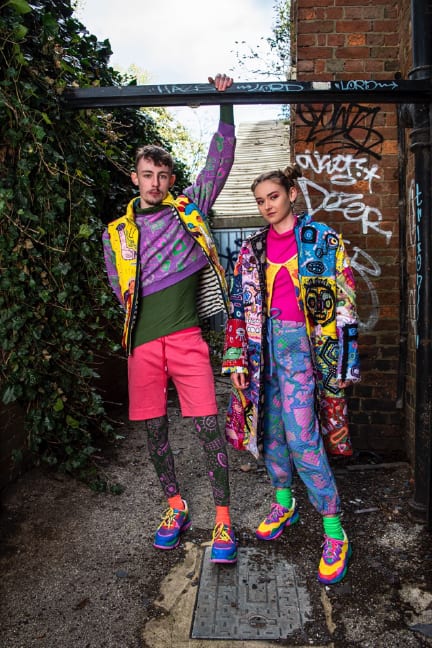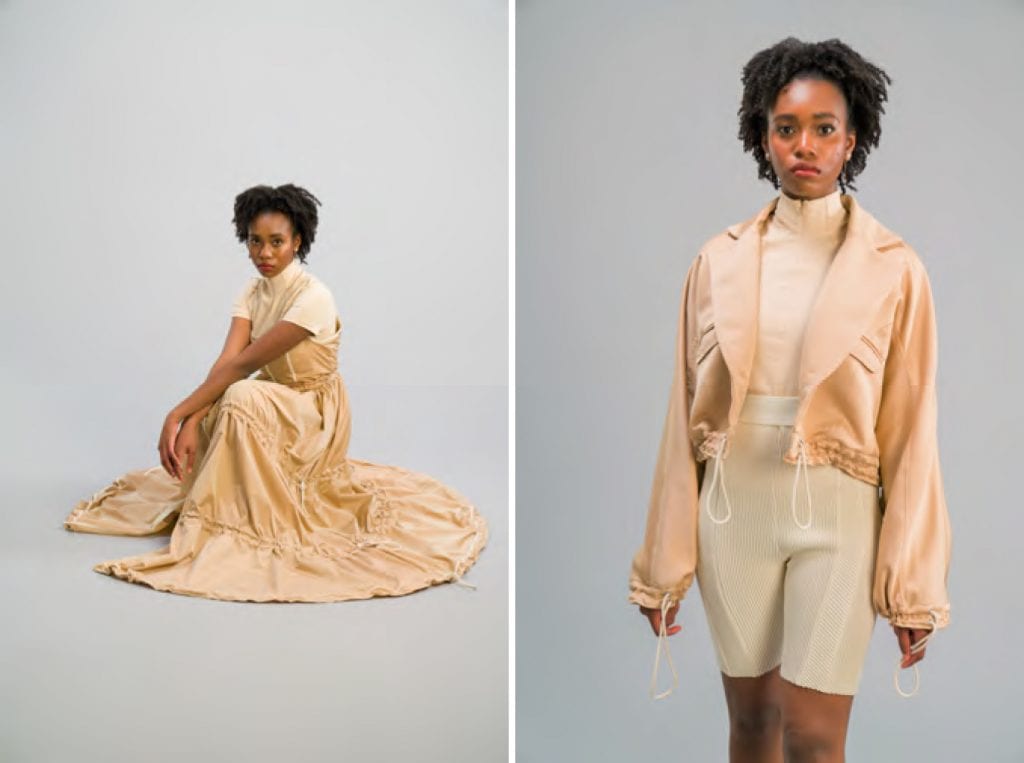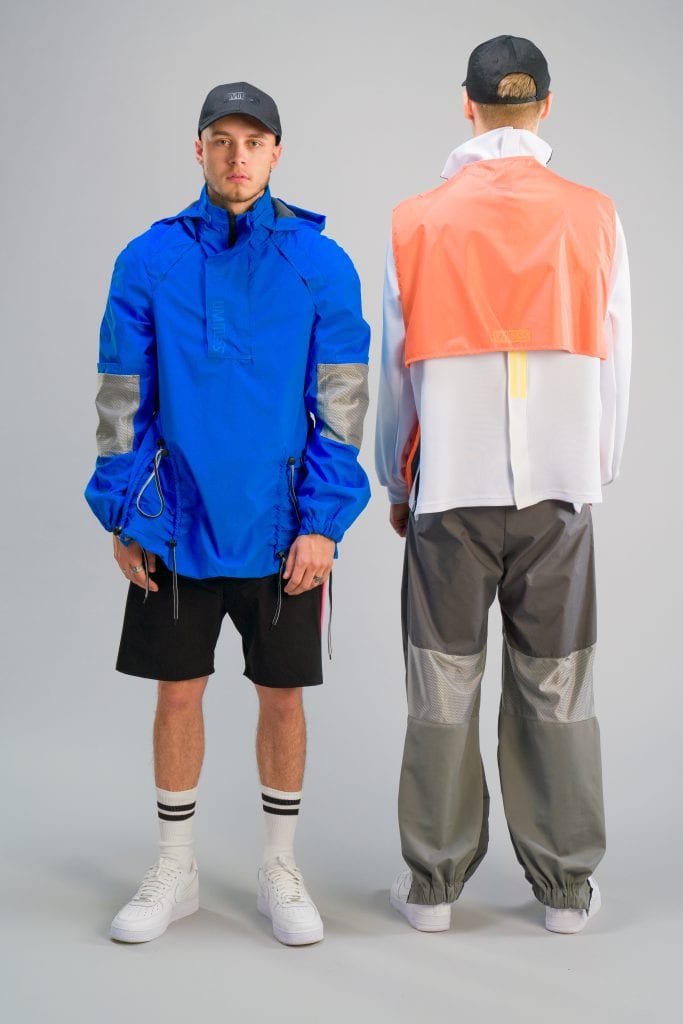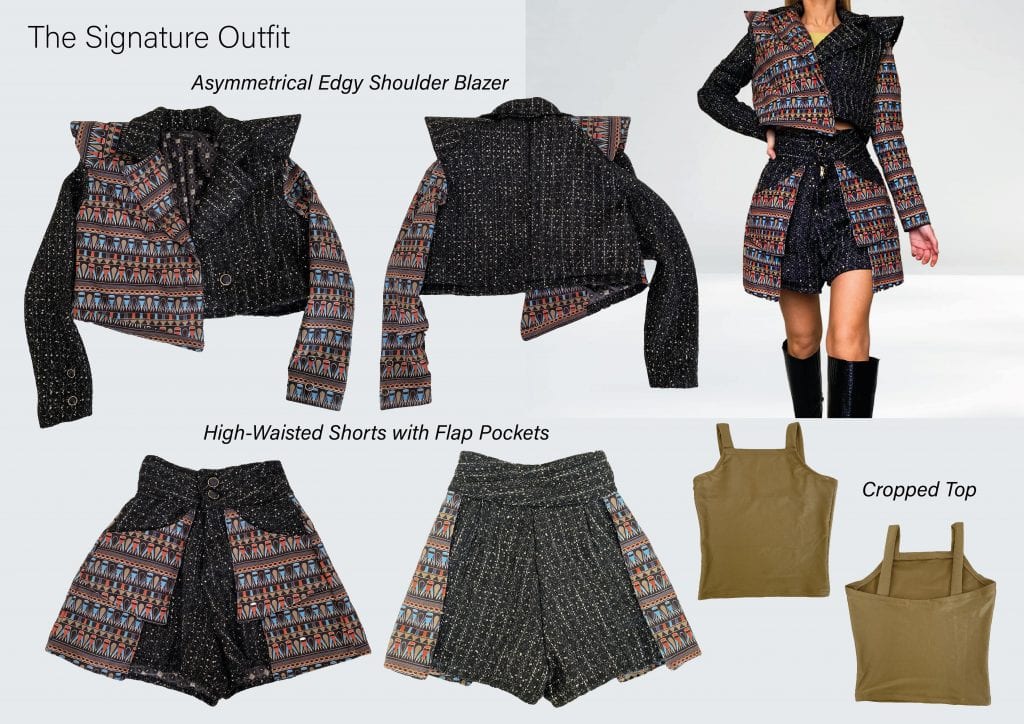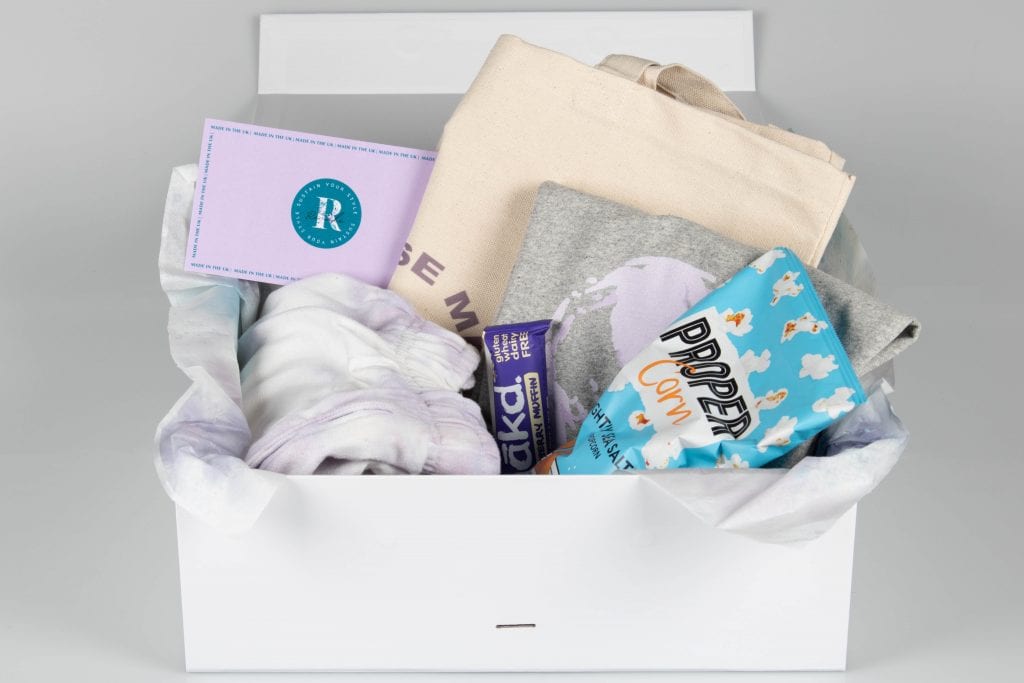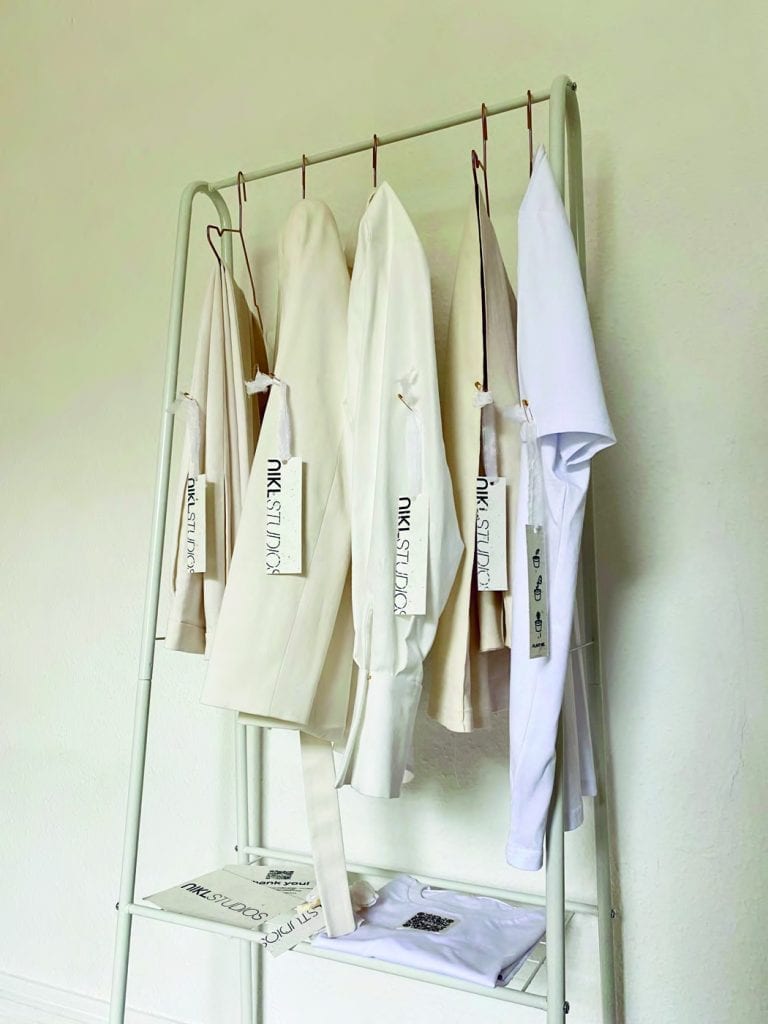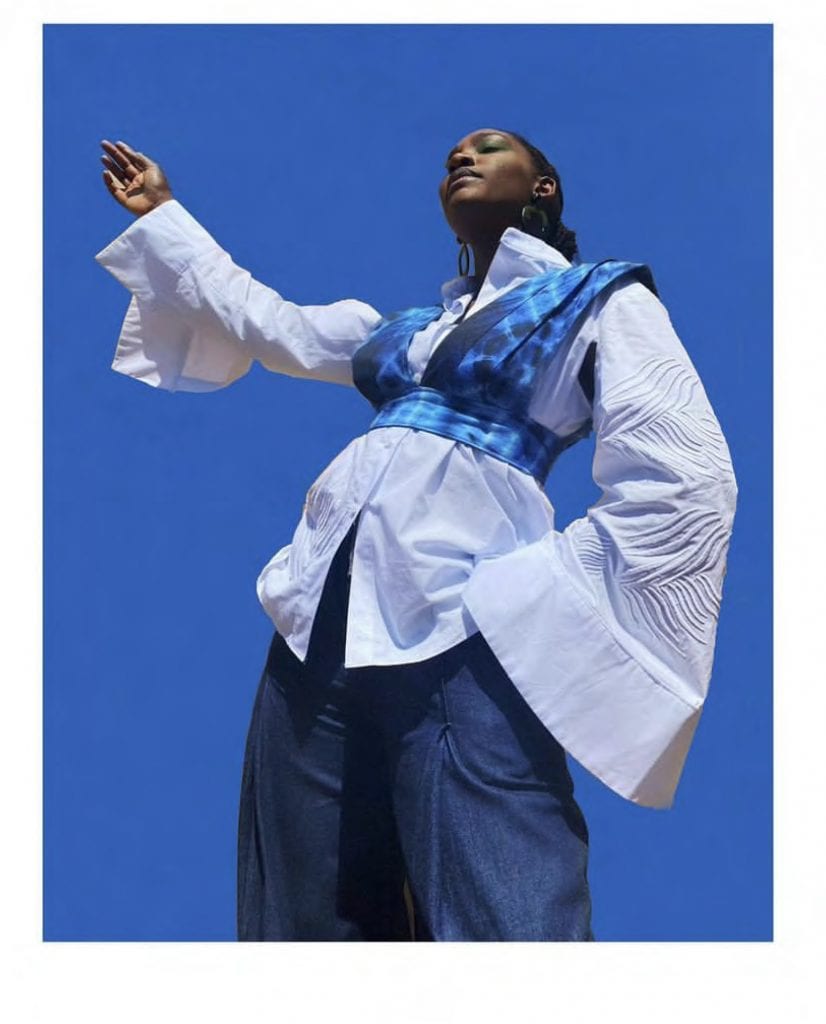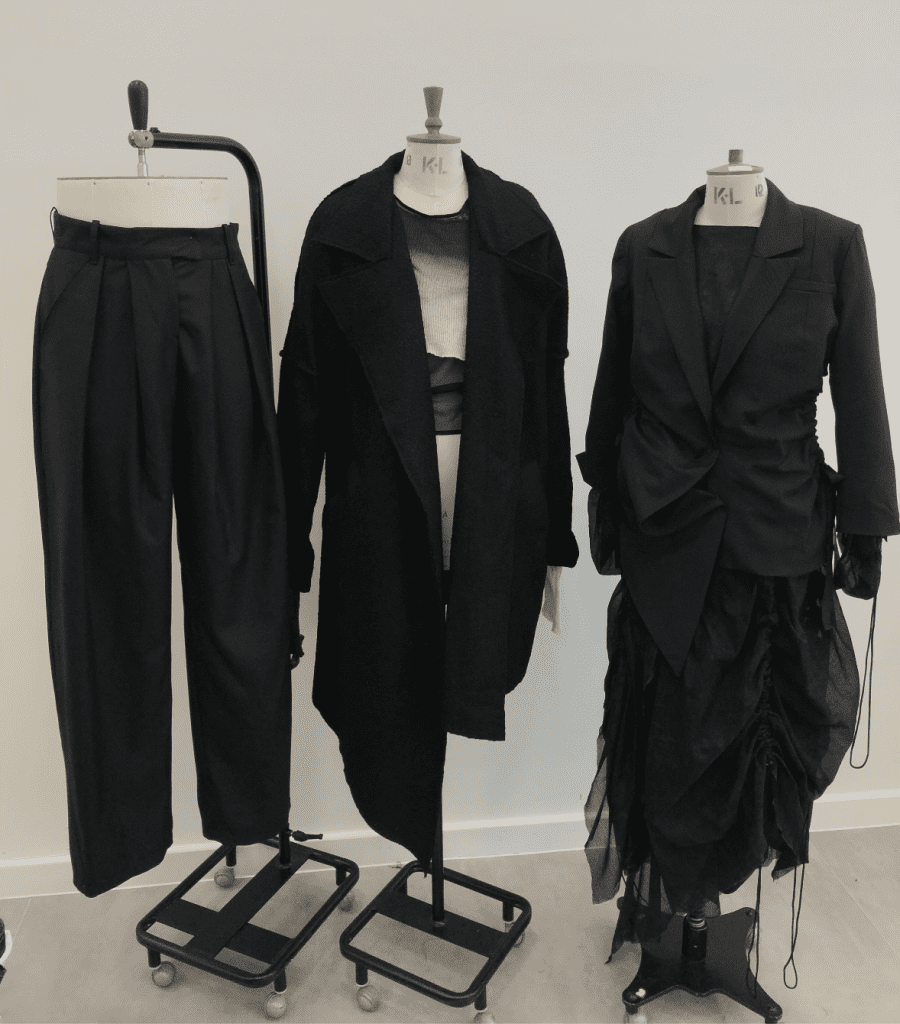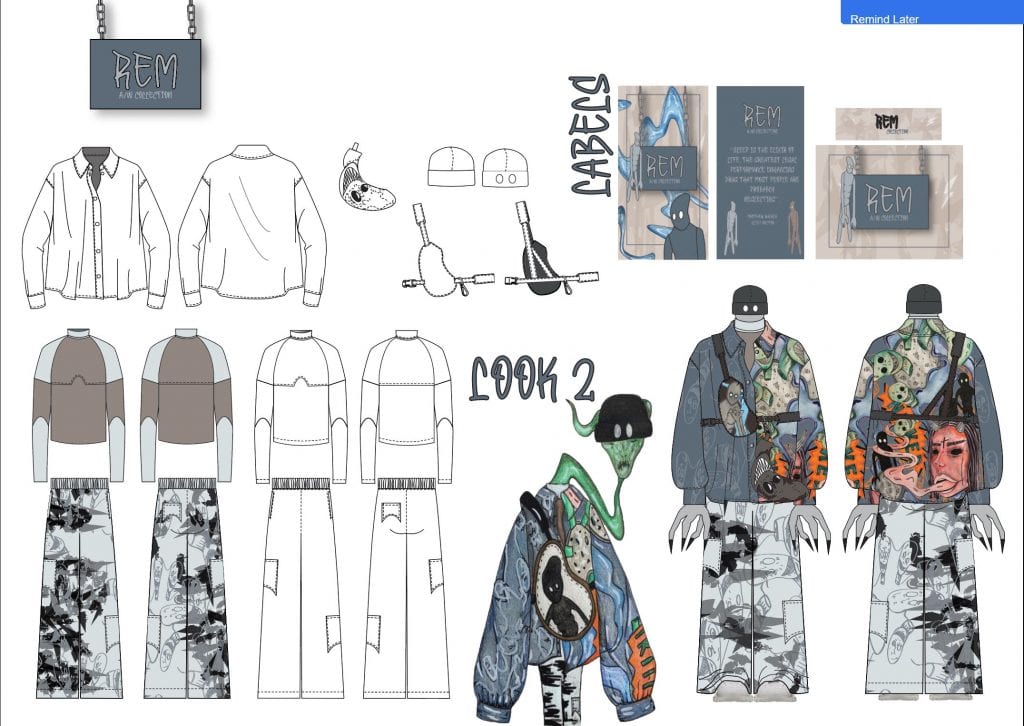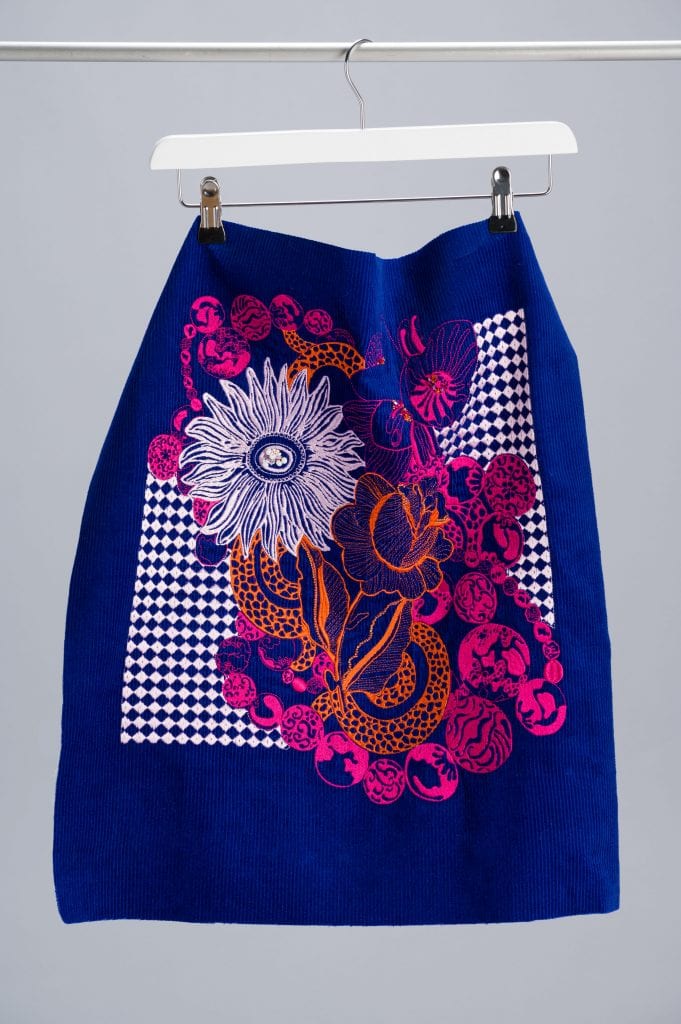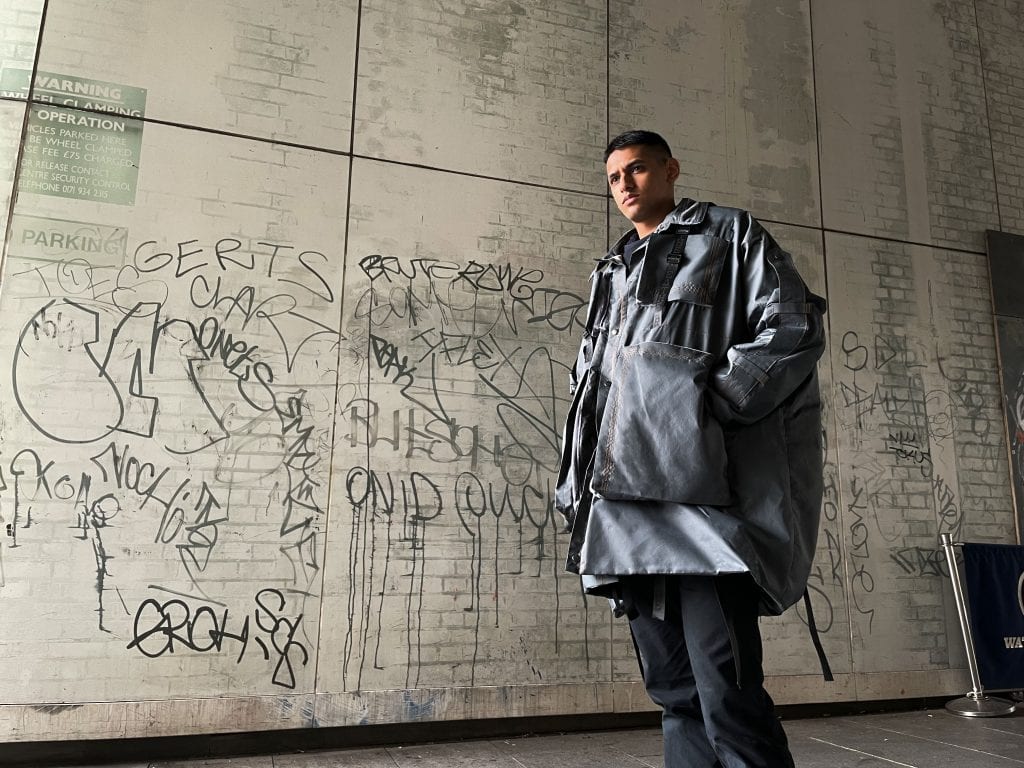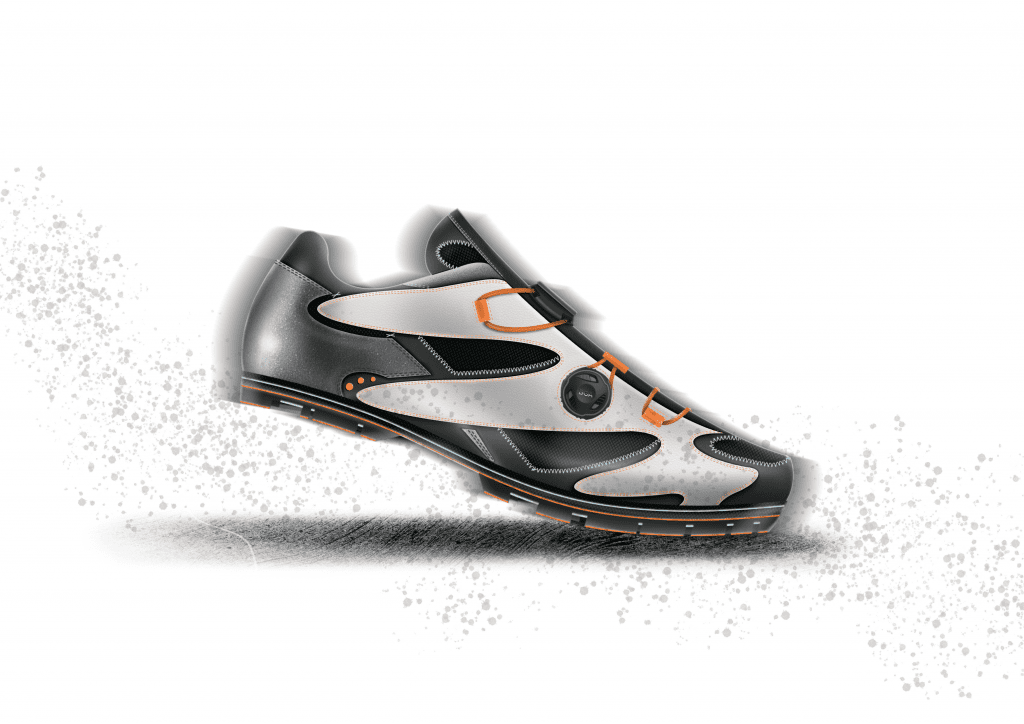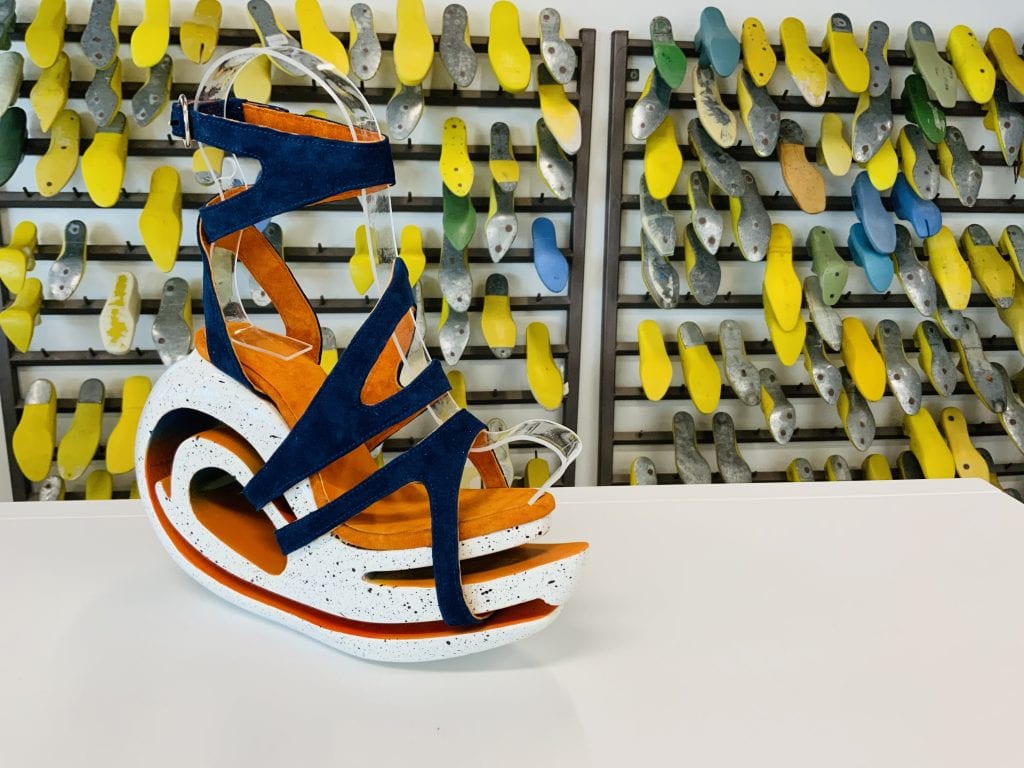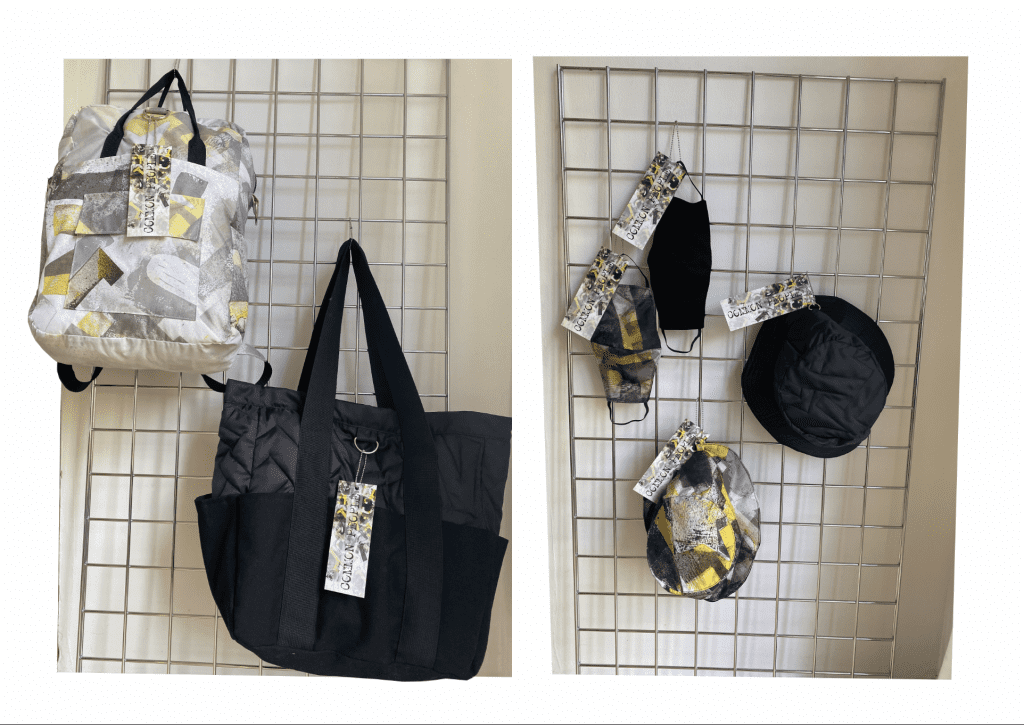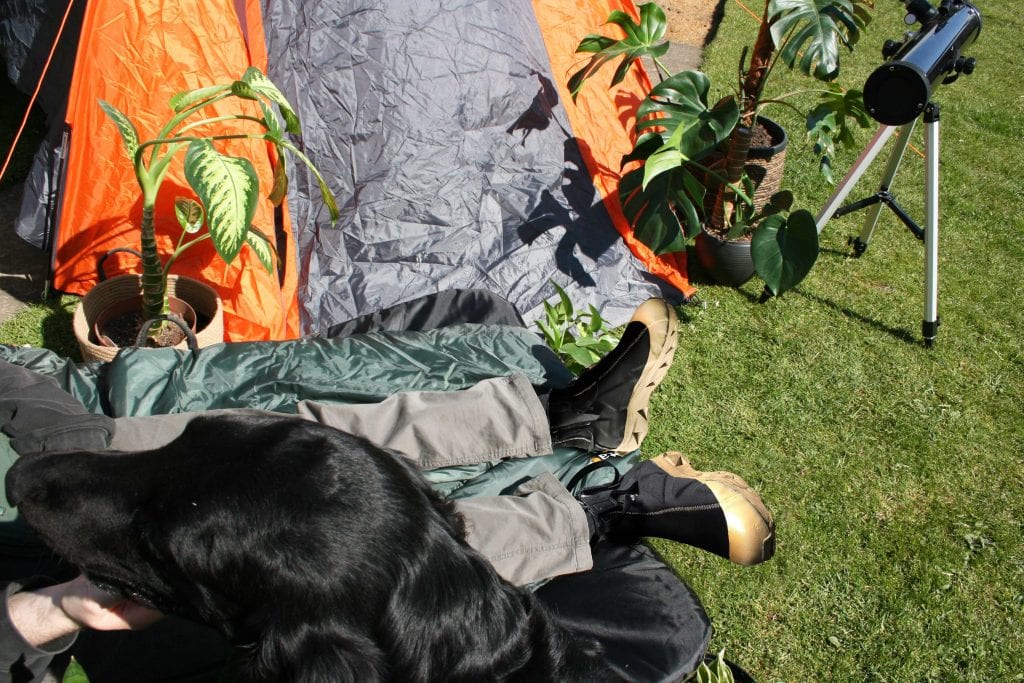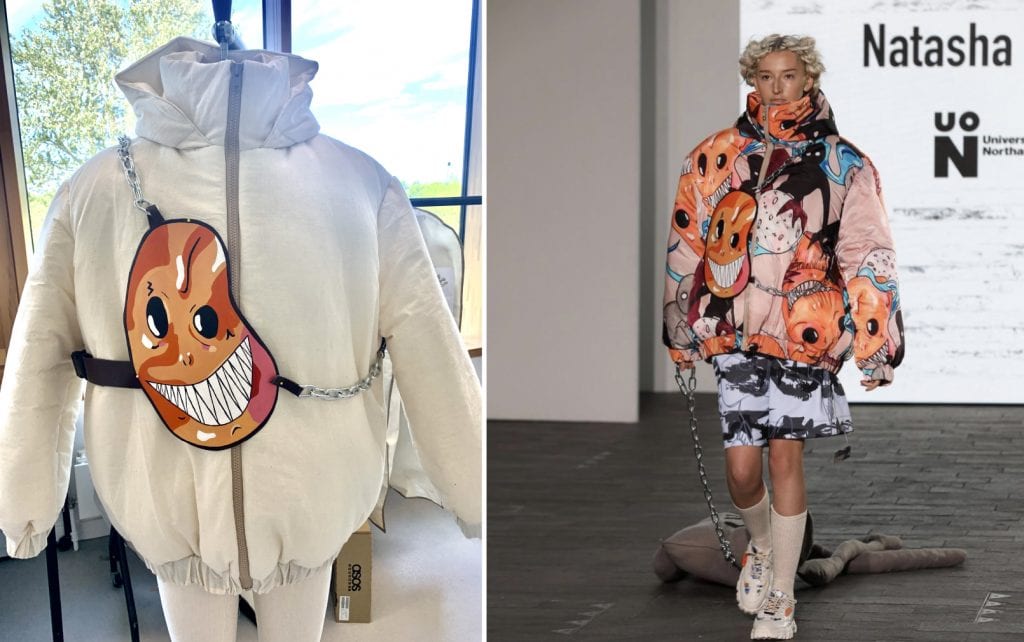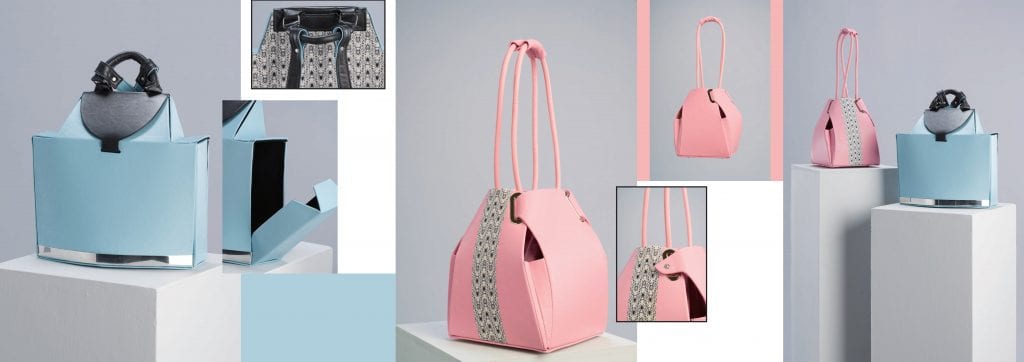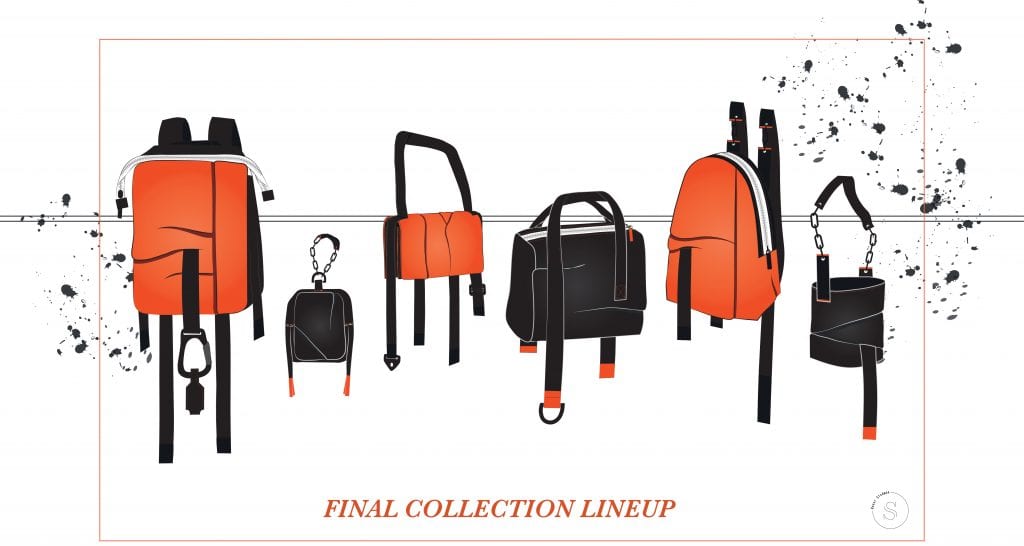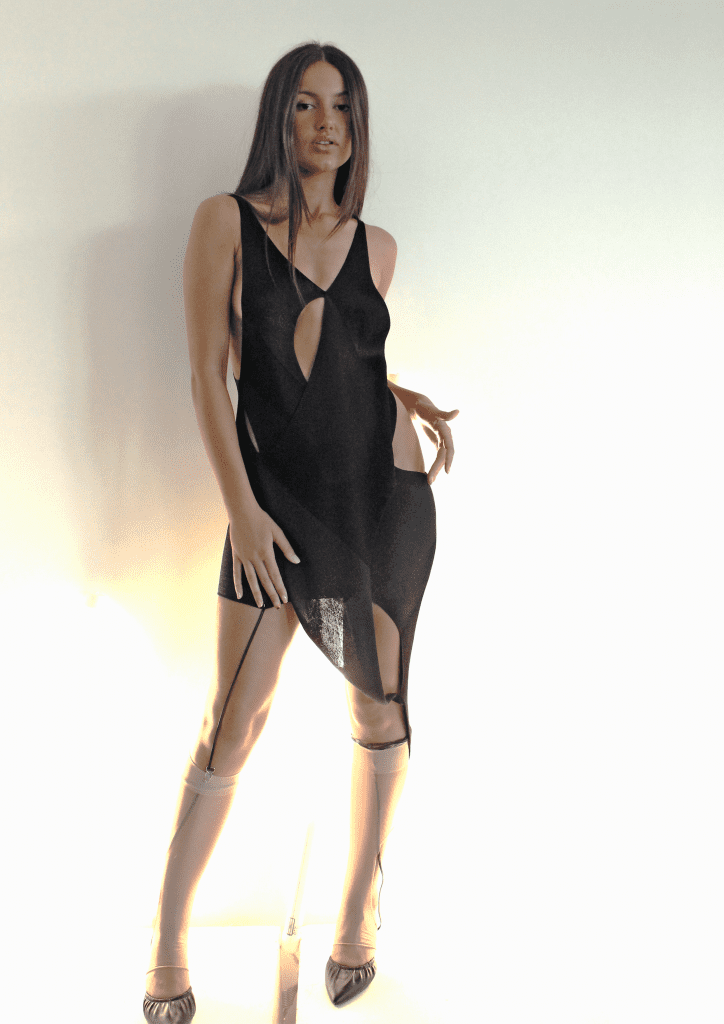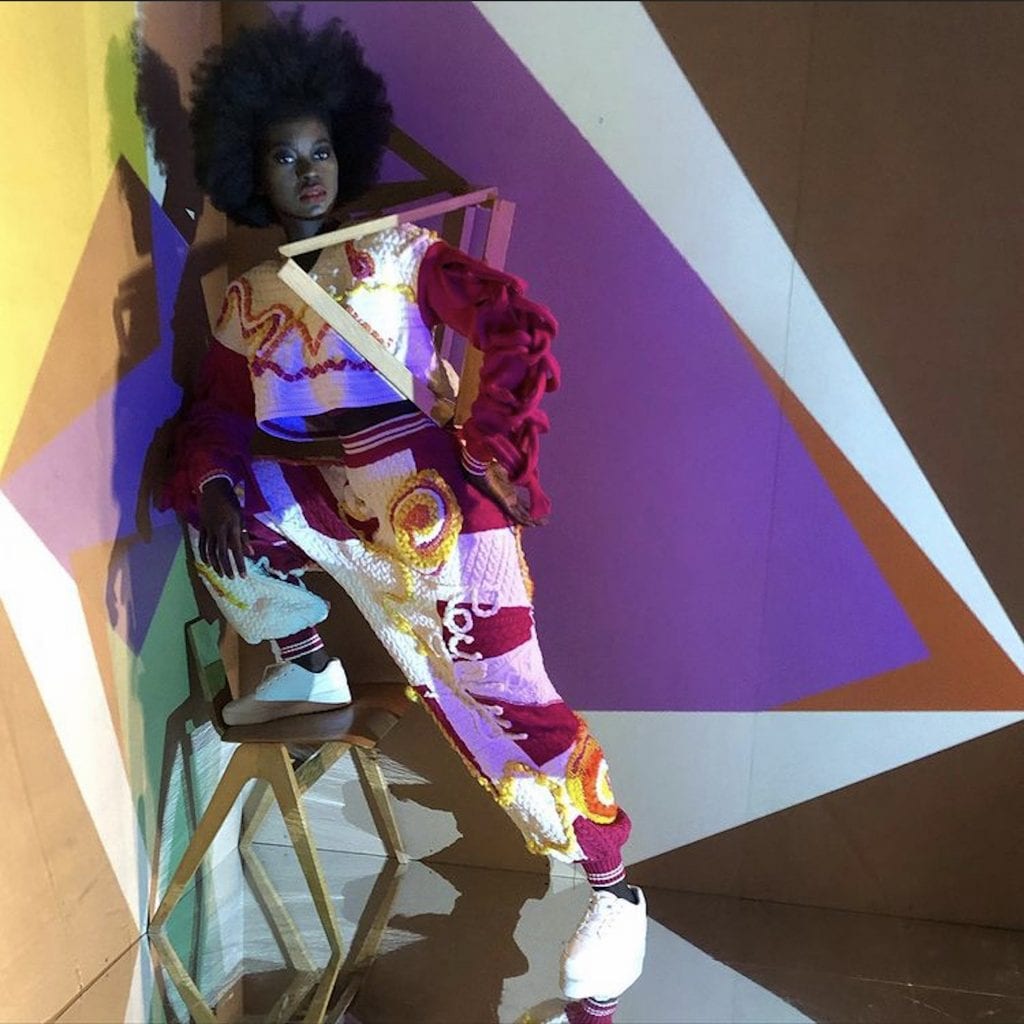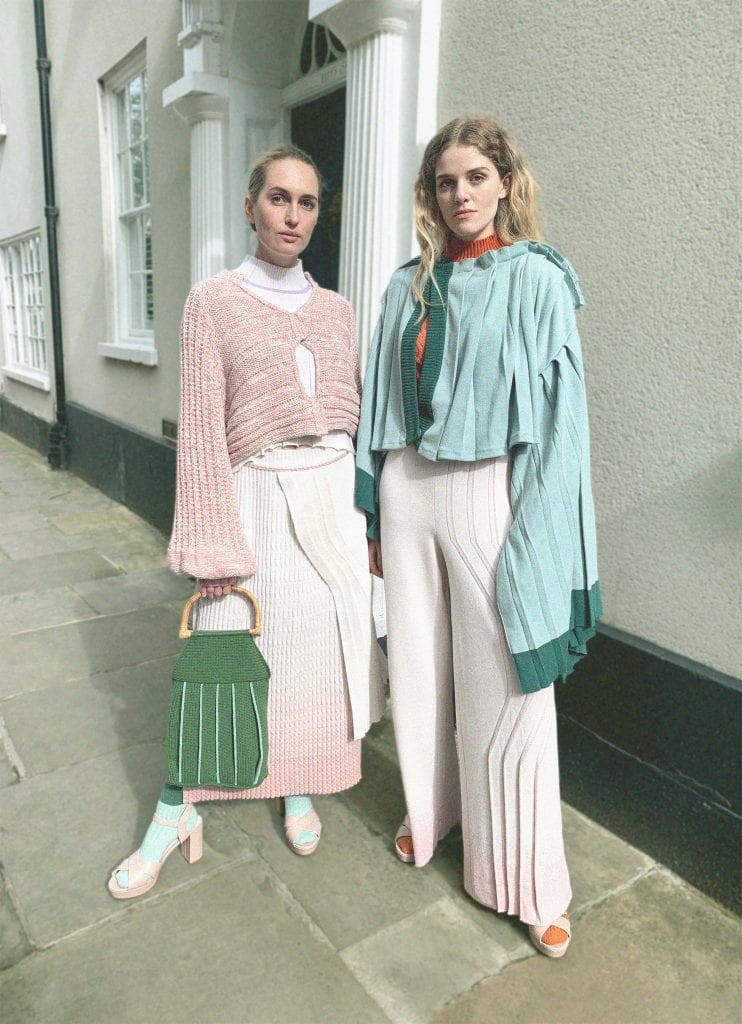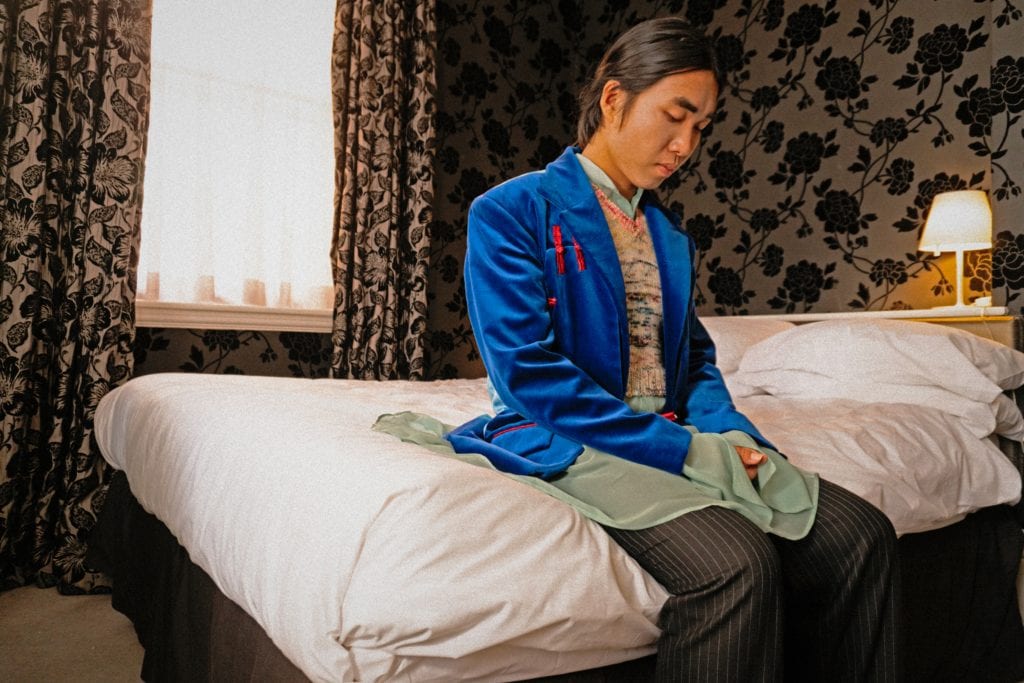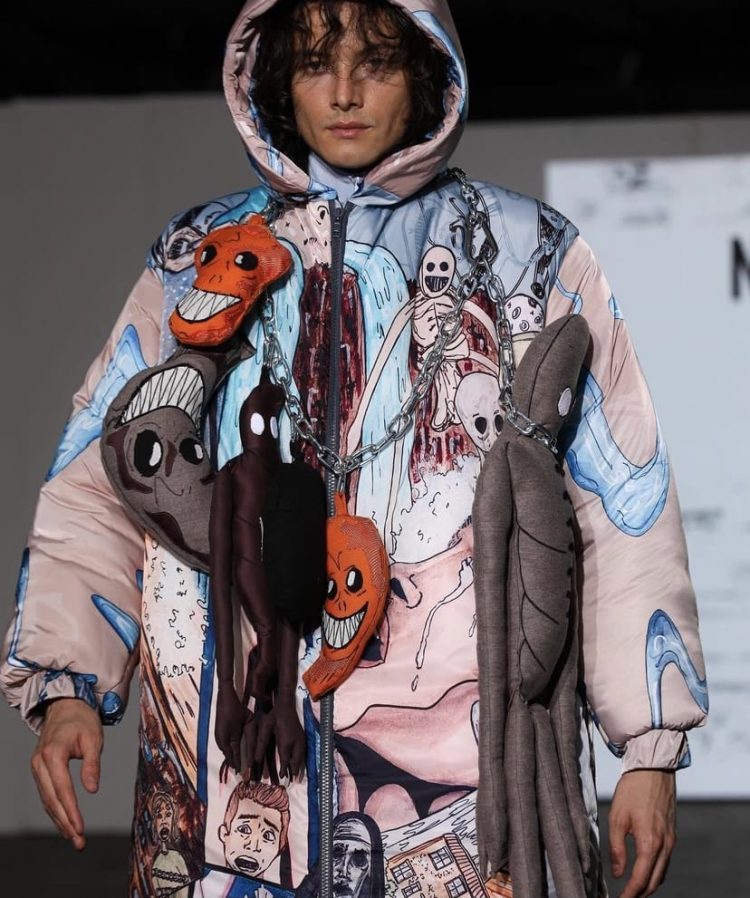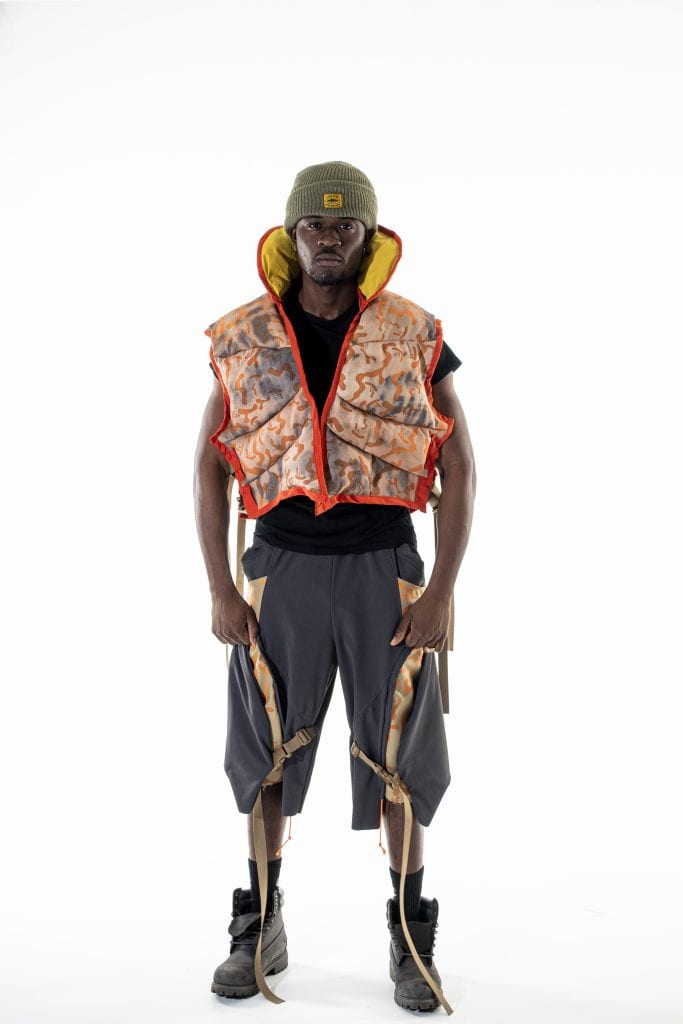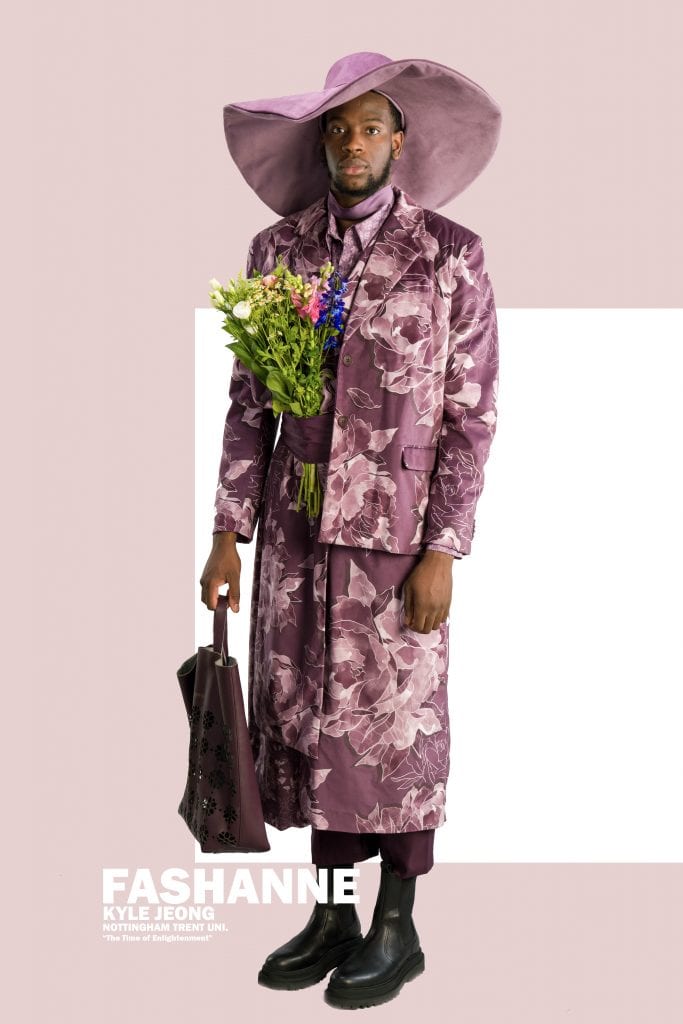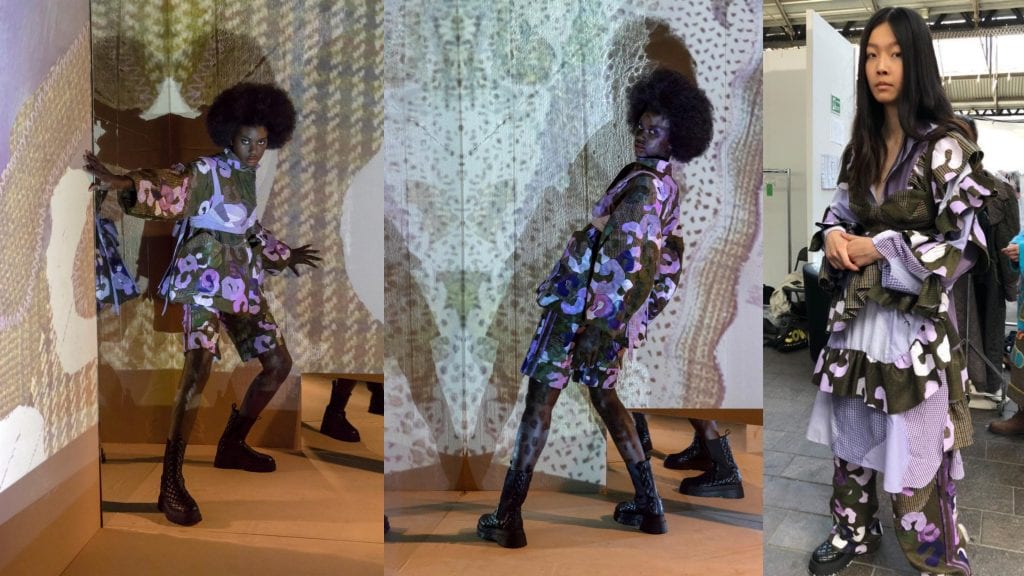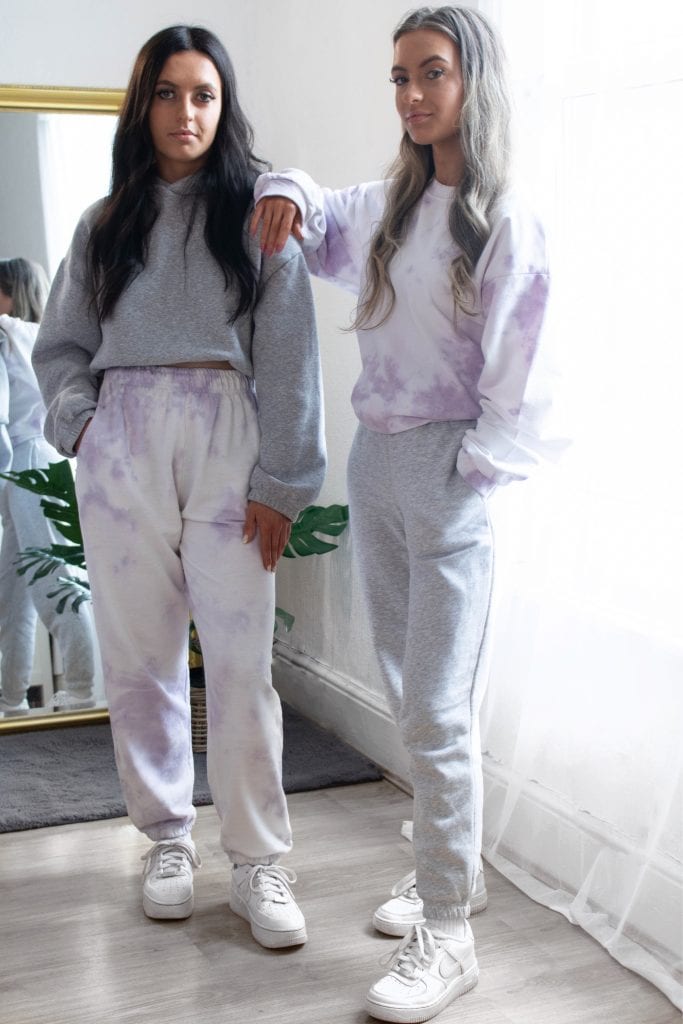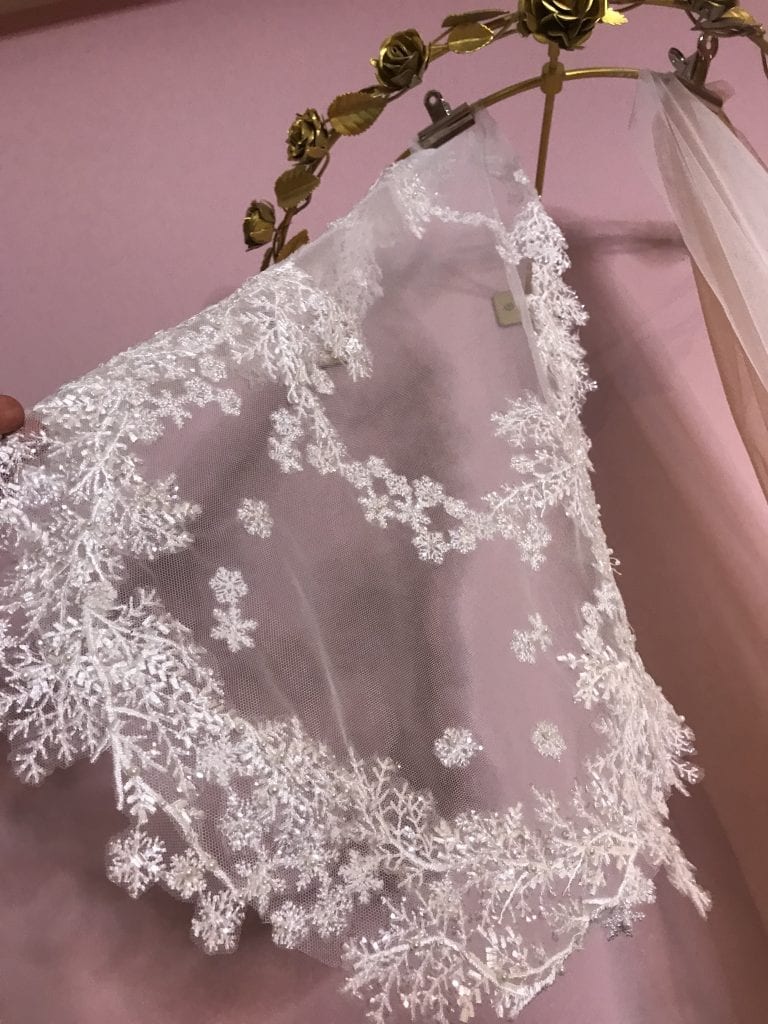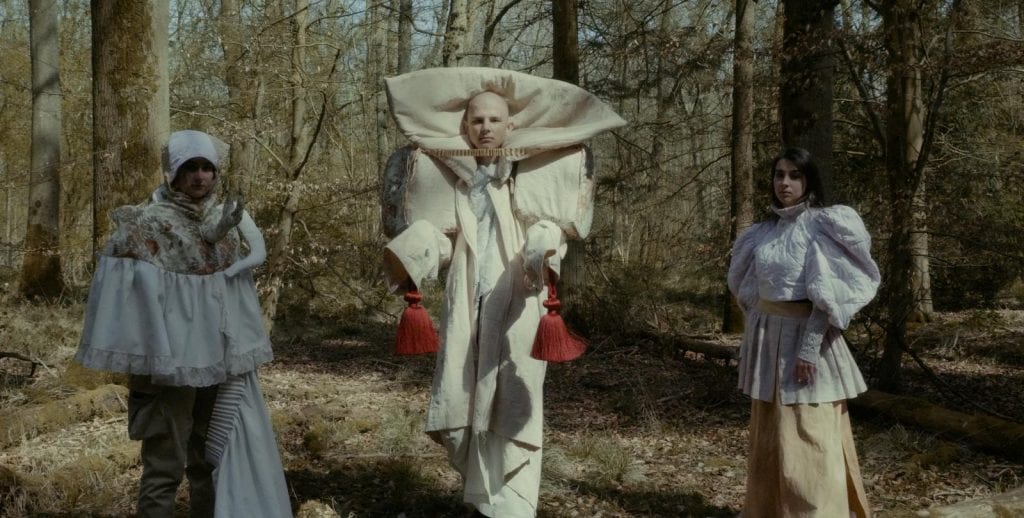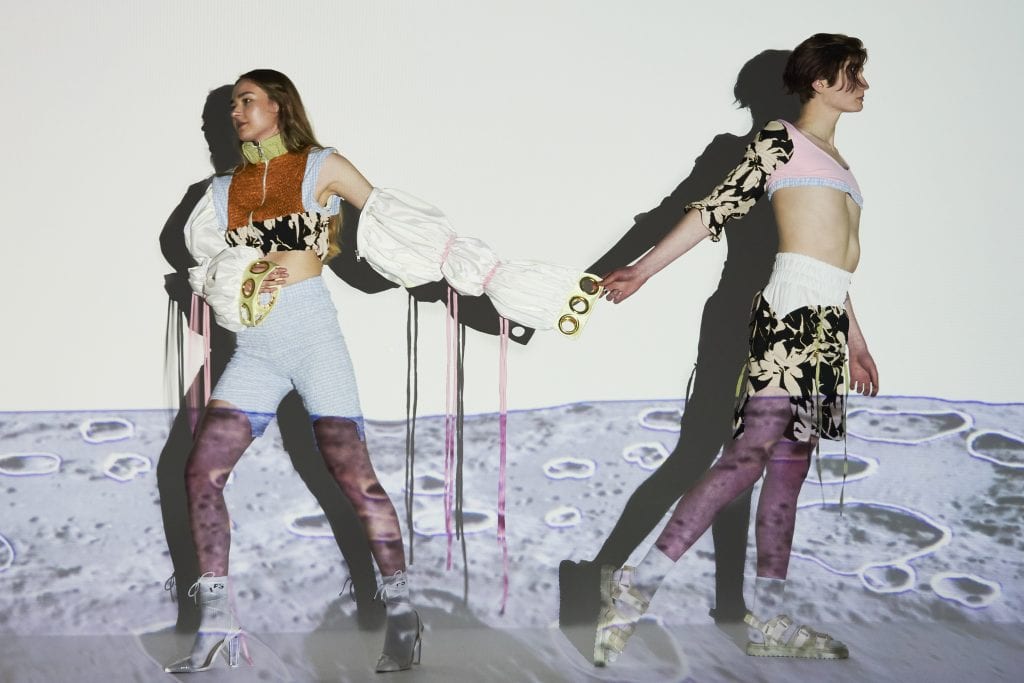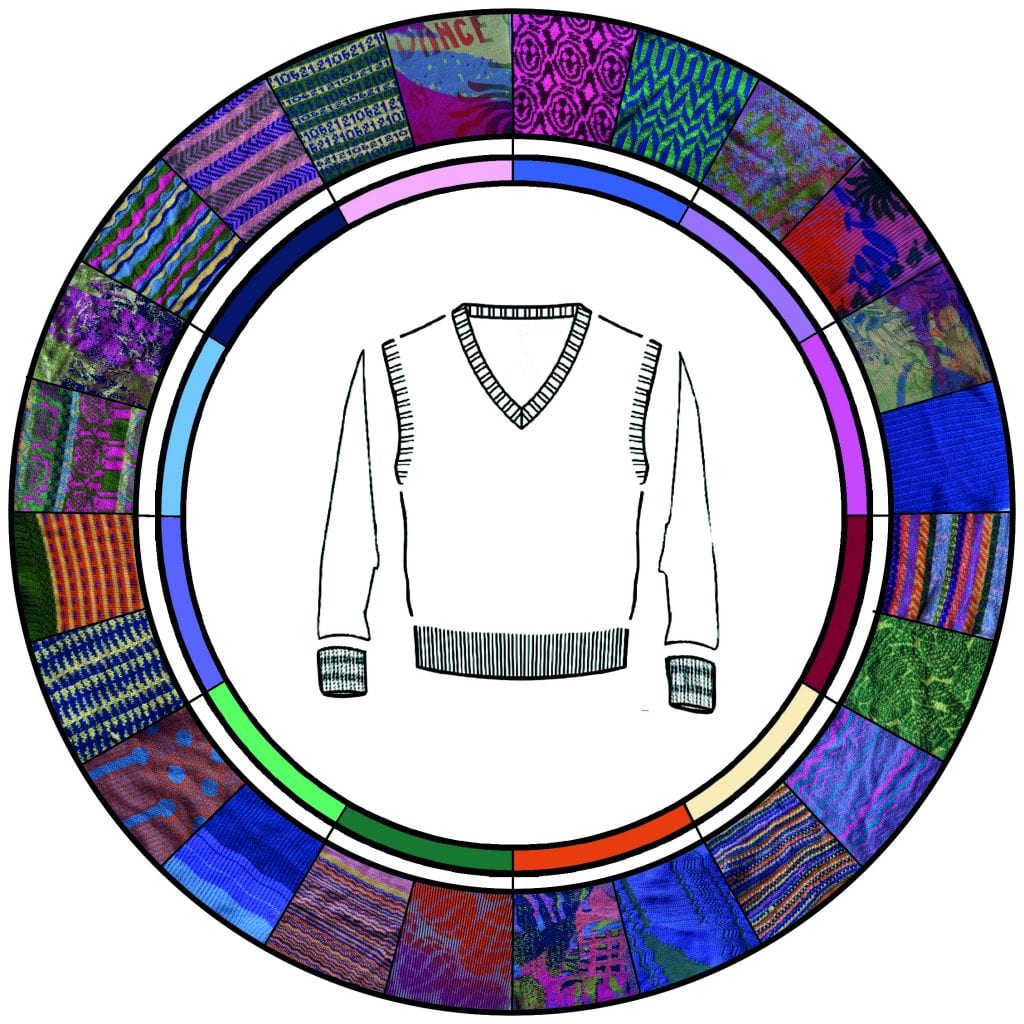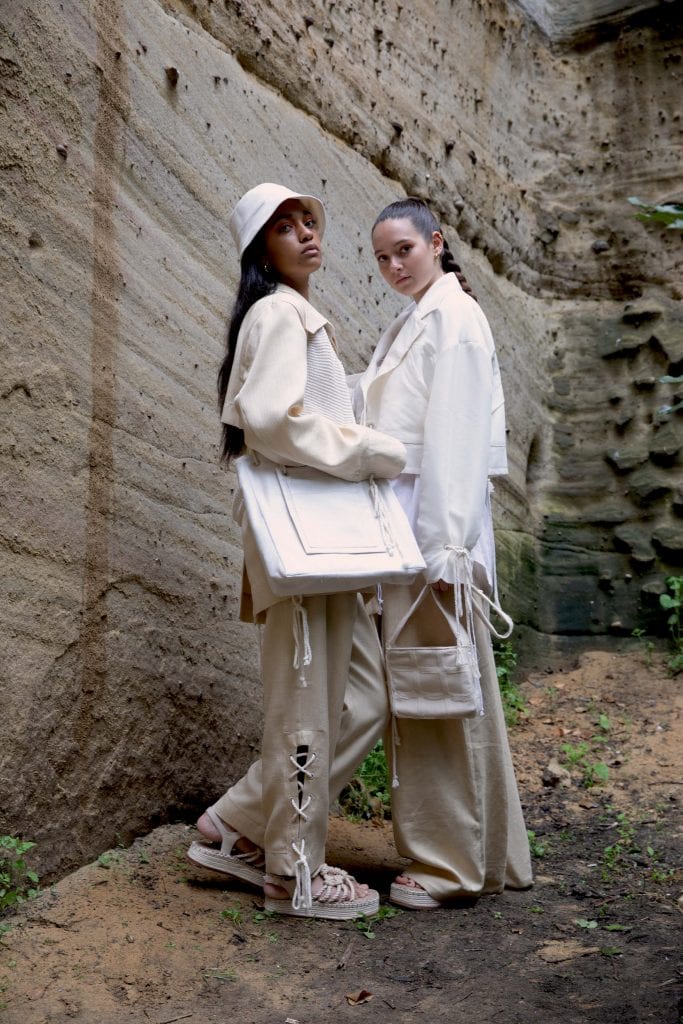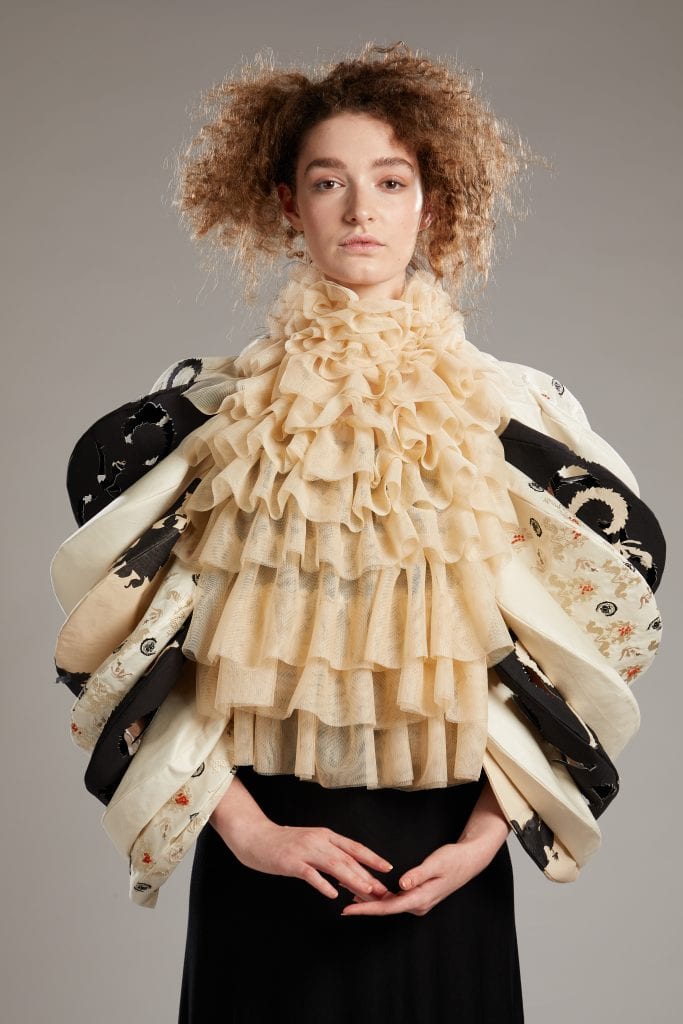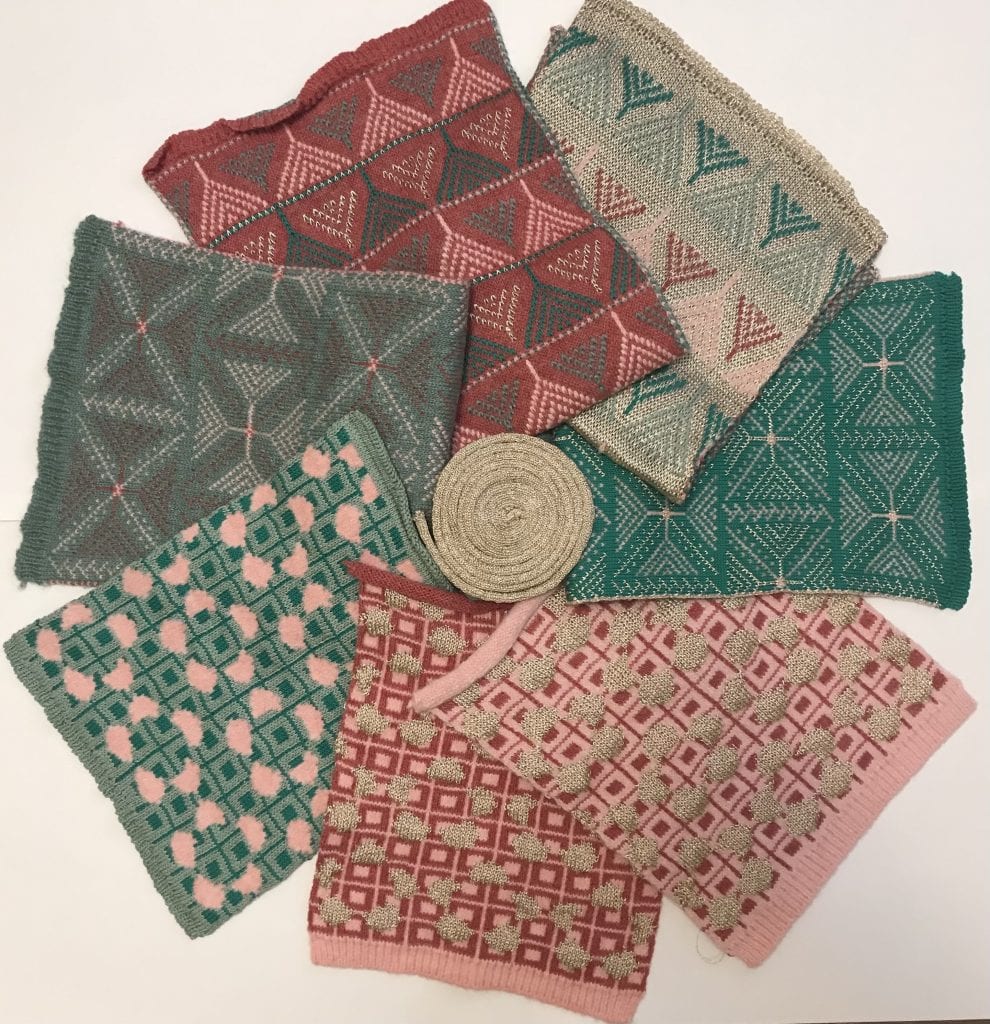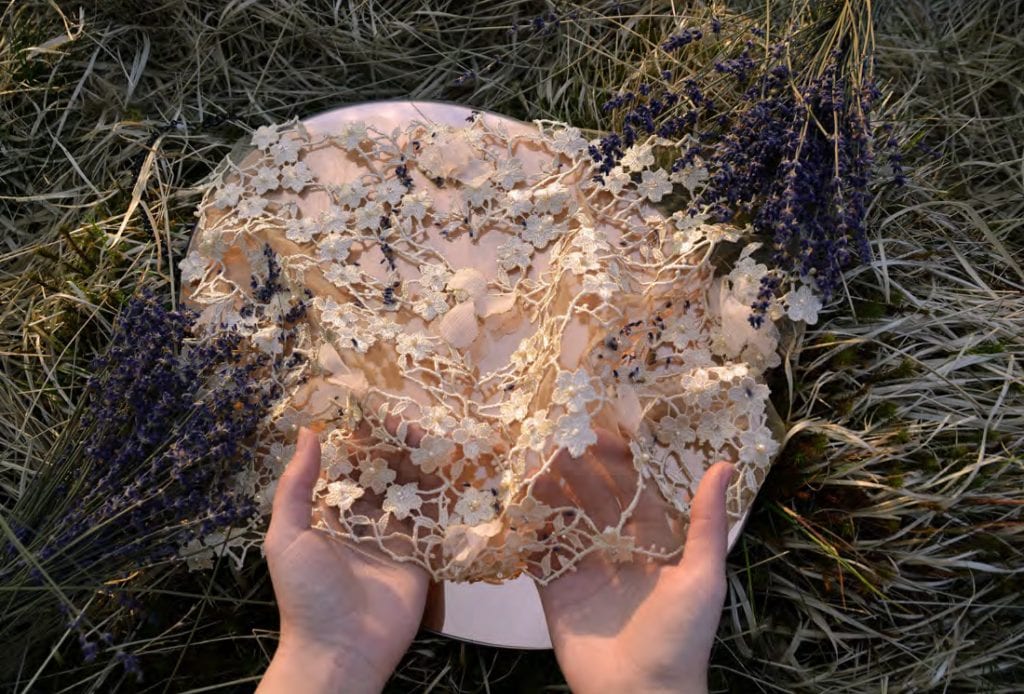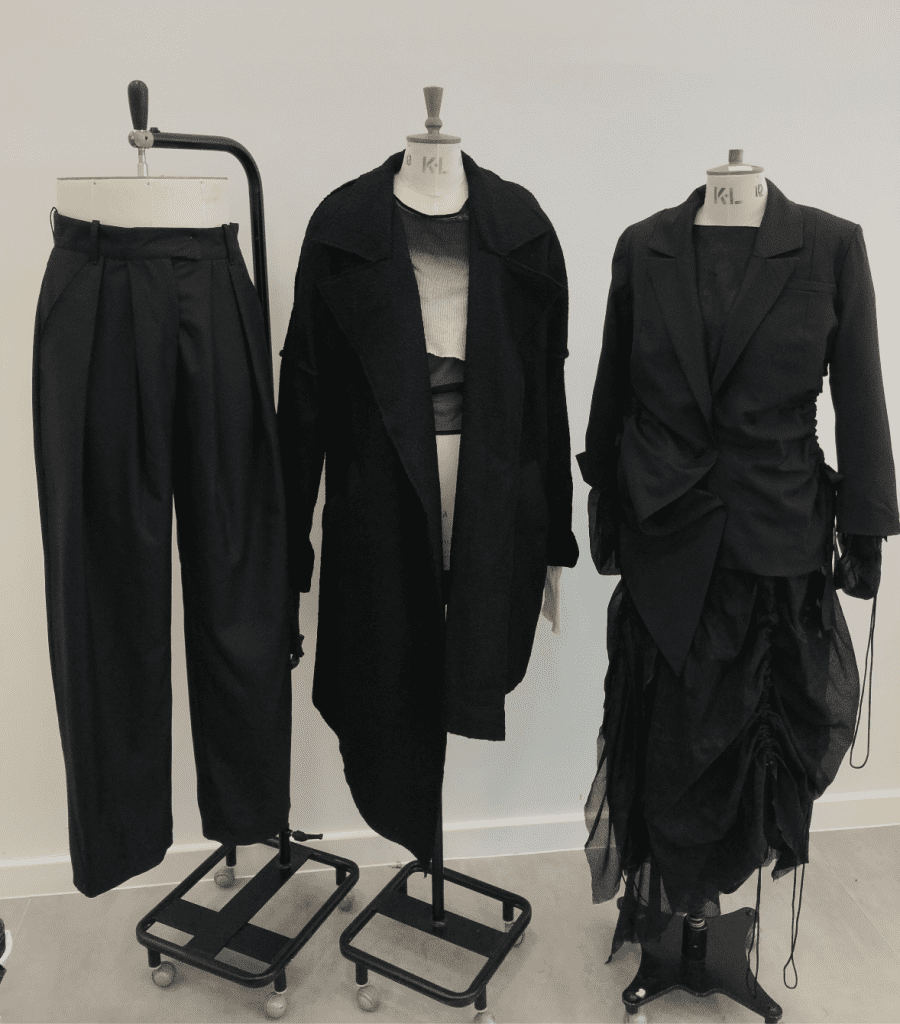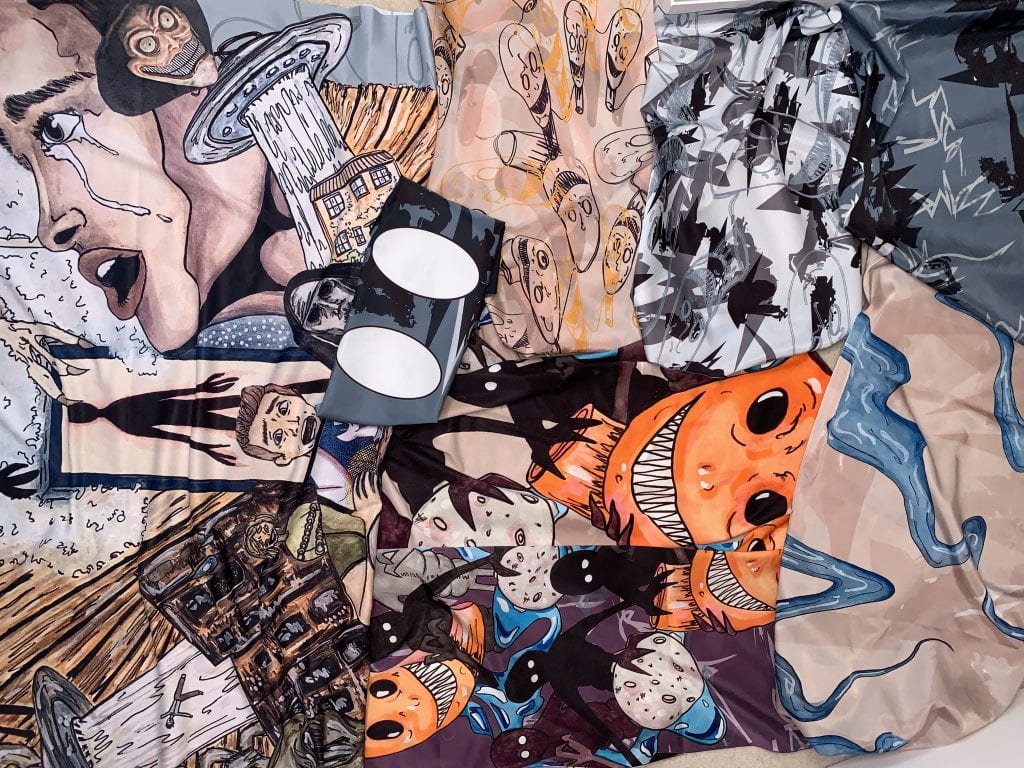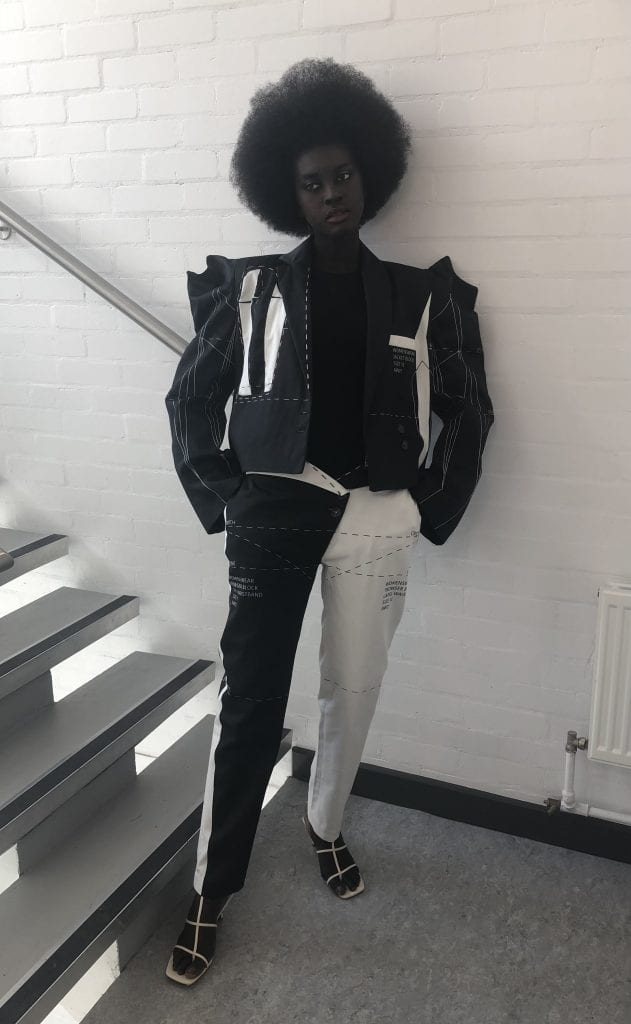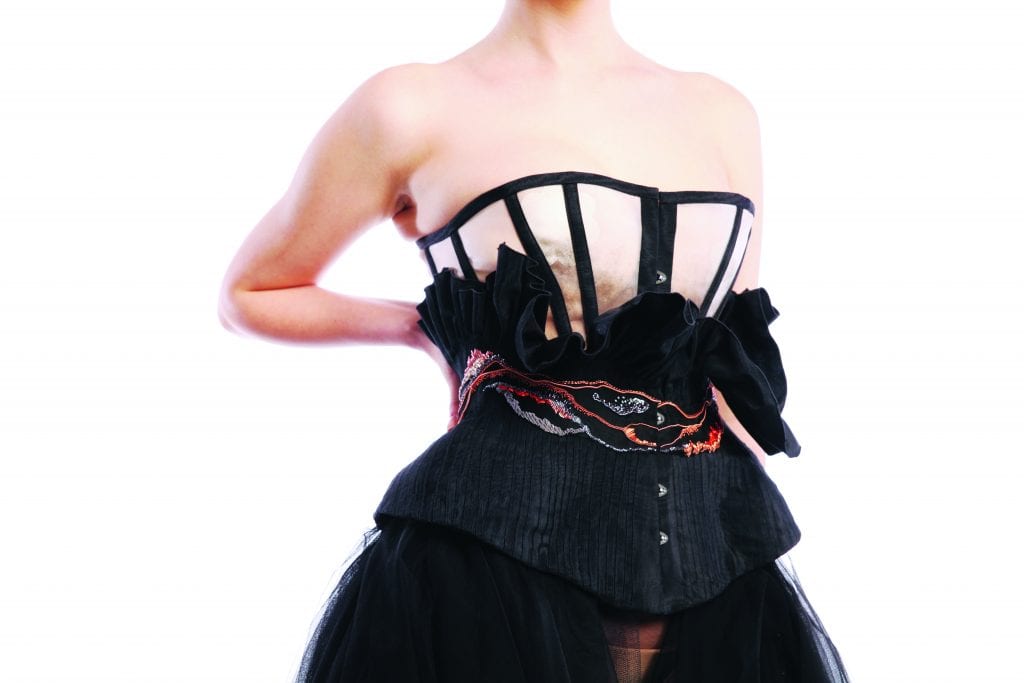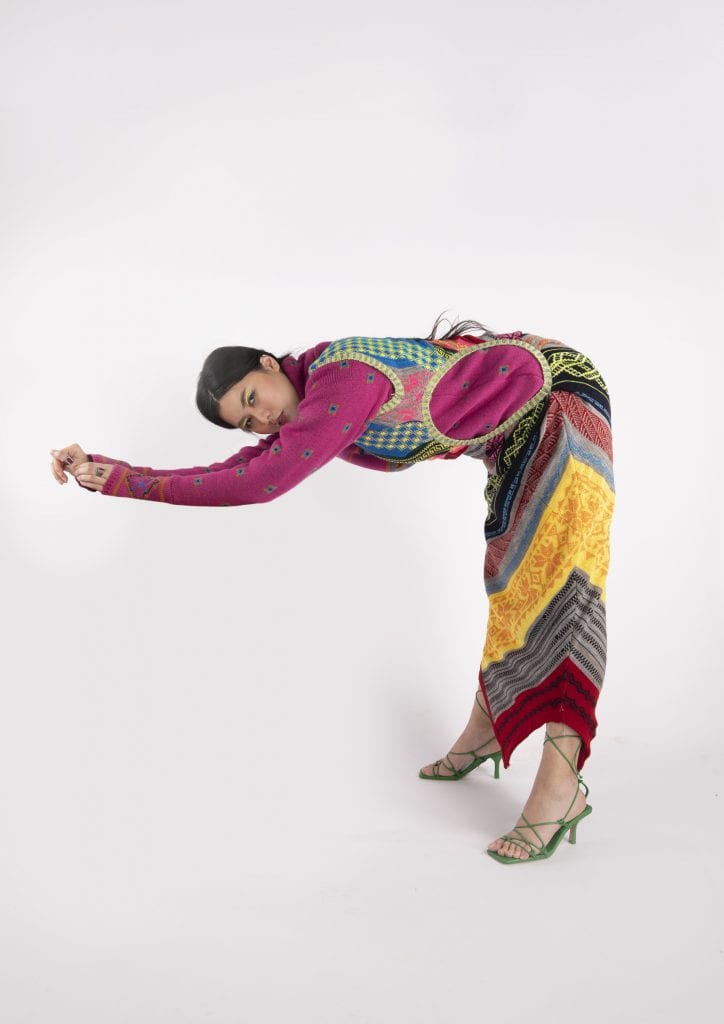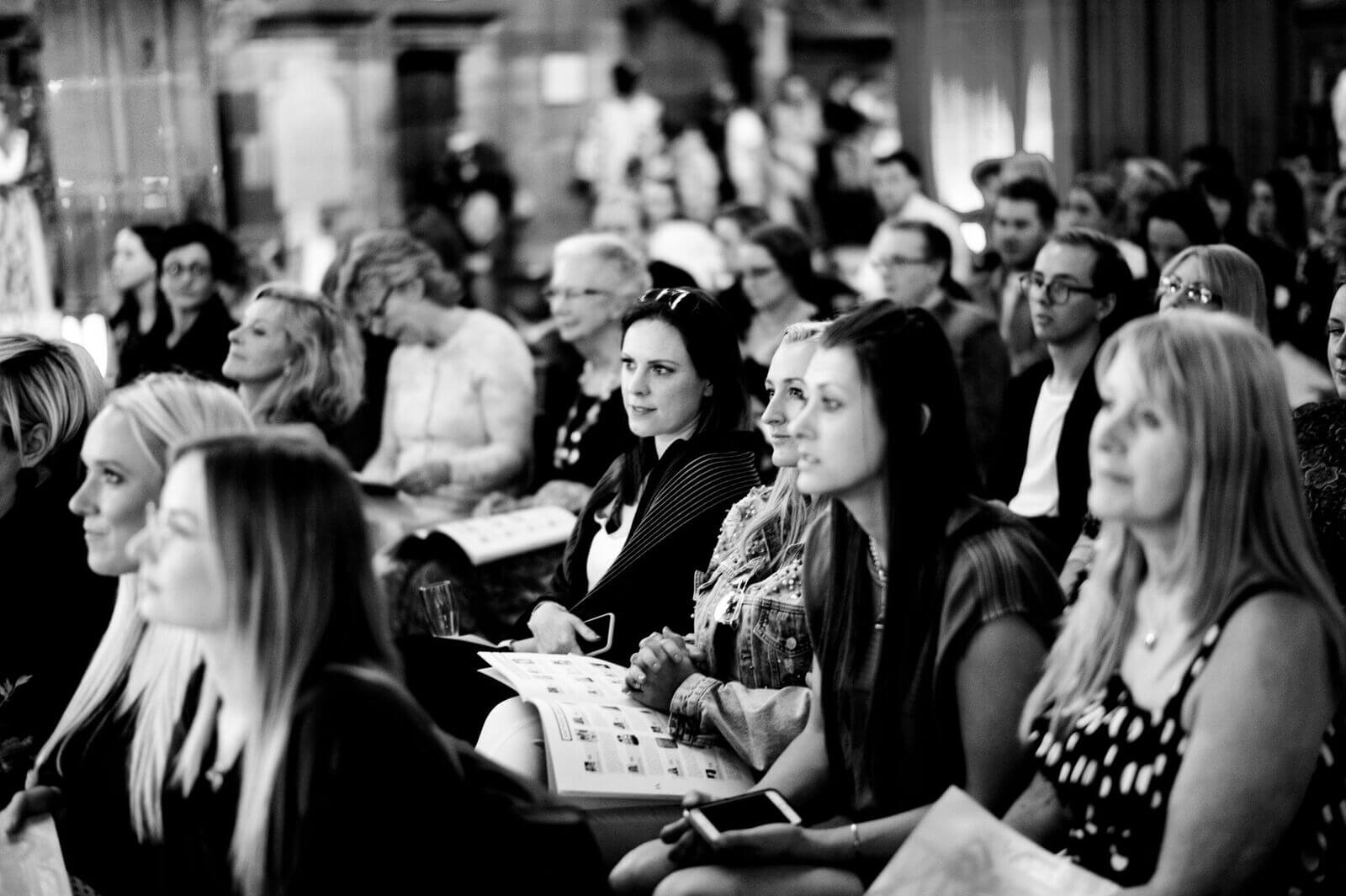
Online Awards 2021
To recognise the talent of 2021 3rd year fashion and textile students, Fashanne hosted 9 ONLINE AWARDS. Unfortunately, we could not host the awards event in May due to the Covid-19 pandemic, yet we are all set for 2022!
Students from 5 universities are taking part this year – De Montfort University, University of Derby, University of Huddersfield, University of Northampton and Nottingham Trent University.
There were 8 category awards: Athleisure Design, Commercial Design, Footwear & Accessory Design, Knitwear Design, Menswear Design, Sustainability, Textile Design and Womenswear Design.
Also, The People’s Choice Award, where the public vote for their favourite.
The FASHANNE ONLINE AWARDS 2021 FILM is below. There is a short and full-length version. The film includes all the entries, judges’ comments and of course who the winners are! A big thank you to all our amazing sponsors, judges and universities who continue to support these awards.
THE 2021 WINNERS ARE:
Athleisure Design: Georgie Lee – University of Northampton
Commercial Design: Sofie Nikl – University of Derby
Footwear & Accessory Design: Kwok Hei Tung – Nottingham Trent University
Knitwear Design: Kaya Vaughan-Walcott – De Montfort University
Menswear Design: Anika Vo – University of Derby
Sustainability: Dominica Buonasorte – University of Derby
Textile Design: Natasha Finlay – University of Northampton
Womenswear Design: Parasto Qalandari – University of Derby
People’s Choice Award: Paulina Golovasovaite – De Montfort University
Here it is…the FASHANNE AWARDS 2021 FILM.
A big thank you to all the students, tutors, sponsors and judges that were all a huge part of this year’s awards. I hope you all agree, the standard of work is outstanding. Happy viewing and hope to see you in person in May 2022 at St Mary’s Church, Nottingham.
The Athleisure Design Award
Brandi Brown
De Montfort University
An aesthetically pleasing, athleisure collection inspired by the sea waves and focusing mainly on the deep blue hues reflected onto the sea water. Exploring the use of comfort/ relaxation and multi-functional wear while ensuring the overall look has a sophisticated, modern and clean finish. Looking at the depths of new innovative shapes and styles that haven’t been explored further within the athleisure industry. My collection also included elements of sustainable design principles such as a high life span and long durability that can be used on the garments to gain maximum wear.

Ellie Jones
De Montfort University
The Fibonacci code, a collection bound by the laws of sacred geometry, proportions and its symbolism in the skeletal form have been explored through conceptual design and manufacture of womenswear. RTW driven garments with hybrid functionality offer modular and practical fashion resolutions to complement the busy lifestyle of the millennial woman. Led by sustainable credentials, juxtaposing market potentials allows the collection to fall under any of the following fashion fields: bodywear, athleisure and outerwear.
Pioneering of technologically advanced print manufacture methods contour the form via complementary innovation in 3D print and GRDXKN® textiles printing technology.
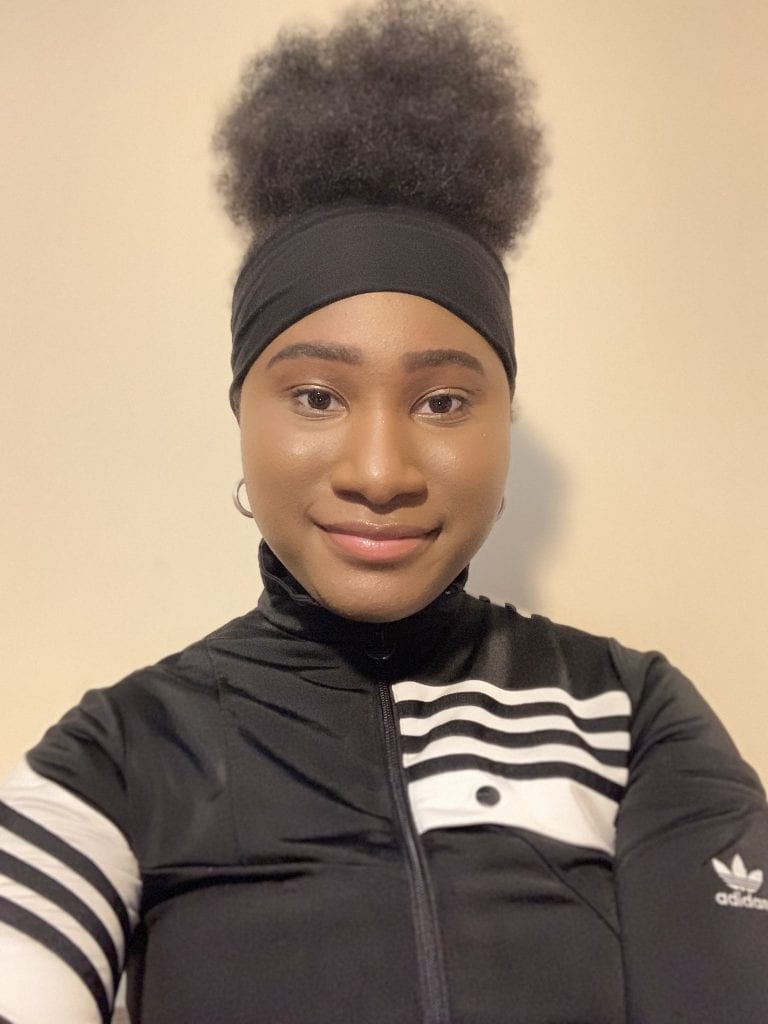
Rhoda Edoyibo
University of Derby
“THE BLA_K SERIES” presents a historical journey of the word race throughout my life to utilise its dark painful history to generate light.
I am narrating a story of self – discovery to celebrate, renovate and reclaim black wealth/pride in a society that extorts my culture.
The Blank Space in my title is intentional to express my concept which is filling in the emotional or historical blanks felt by the African Diaspora. The blank can also be interpreted as the word Black, almost as a way to release the negative connotations associated towards the race and the colour itself.
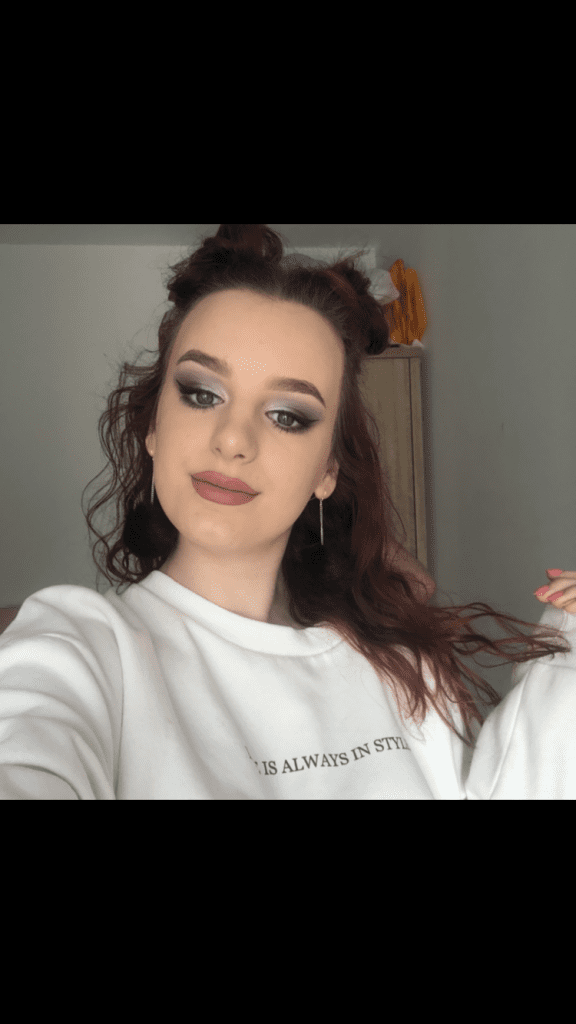
Chloe Twigg
University of Derby
‘ANEMOIA’ is a nostalgic longing for a time you have never lived.
I was inspired by nostalgic 80’s hip hop culture, graffiti and my dance background. Dance is my connection to the culture – a universal human language.
I collaborated with SINS to produce a graffiti piece for my slogan ‘SO I DANCE’, encompassing my passion for dance. Blurring the line between legality and art, graffiti’s transient nature is intrinsically nostalgic. Immersing myself into graffiti culture has informed and validated my work.
Insightful research and first-hand experiences have shaped my collection to evoke anemoia and celebrate hip hop culture.
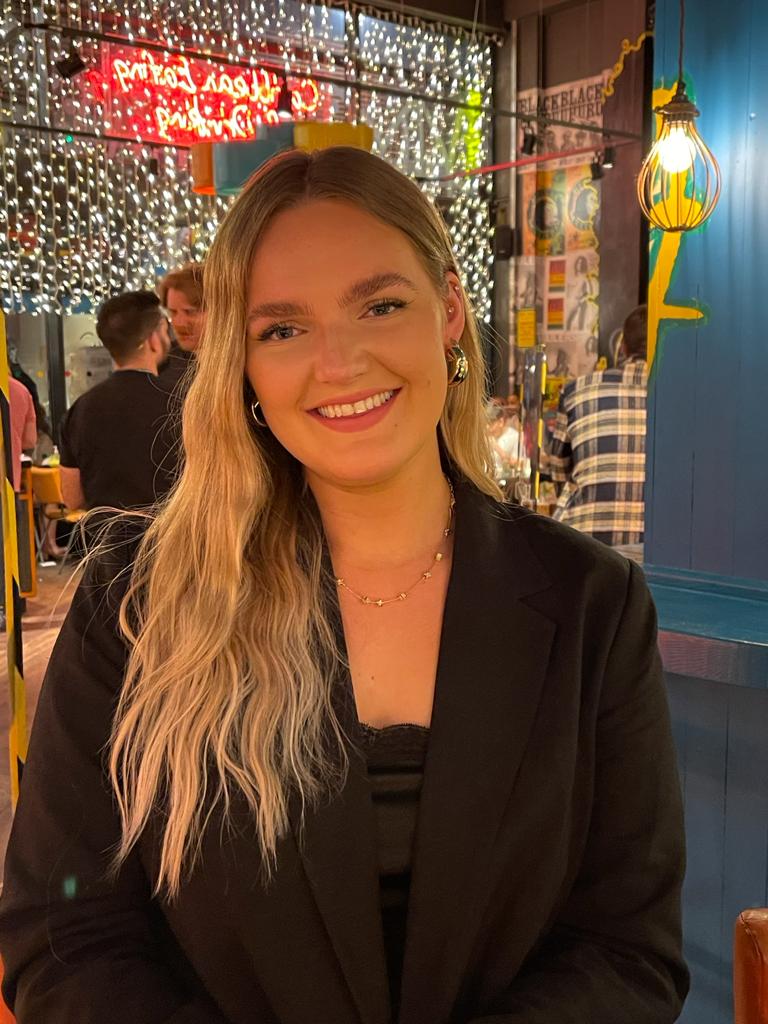
Georgie Lee
University of Northampton
My FMP is based on the idea of surrealism. This post war art movement in 1920’s, aimed to change the perceptions of the world by exploring dreams, the unconscious mind and the irrational. Surrealism was believed to be a way of the escaping the harsh reality of the aftermath of the war by denoting to happier places. This idea of escaping is still relevant now but for different reasons. I will be creating a surreal world inspired by childhood associations, a time of pure blissfulness, to provide an escape into imagination. Whilst referencing skiing, my biggest escape.
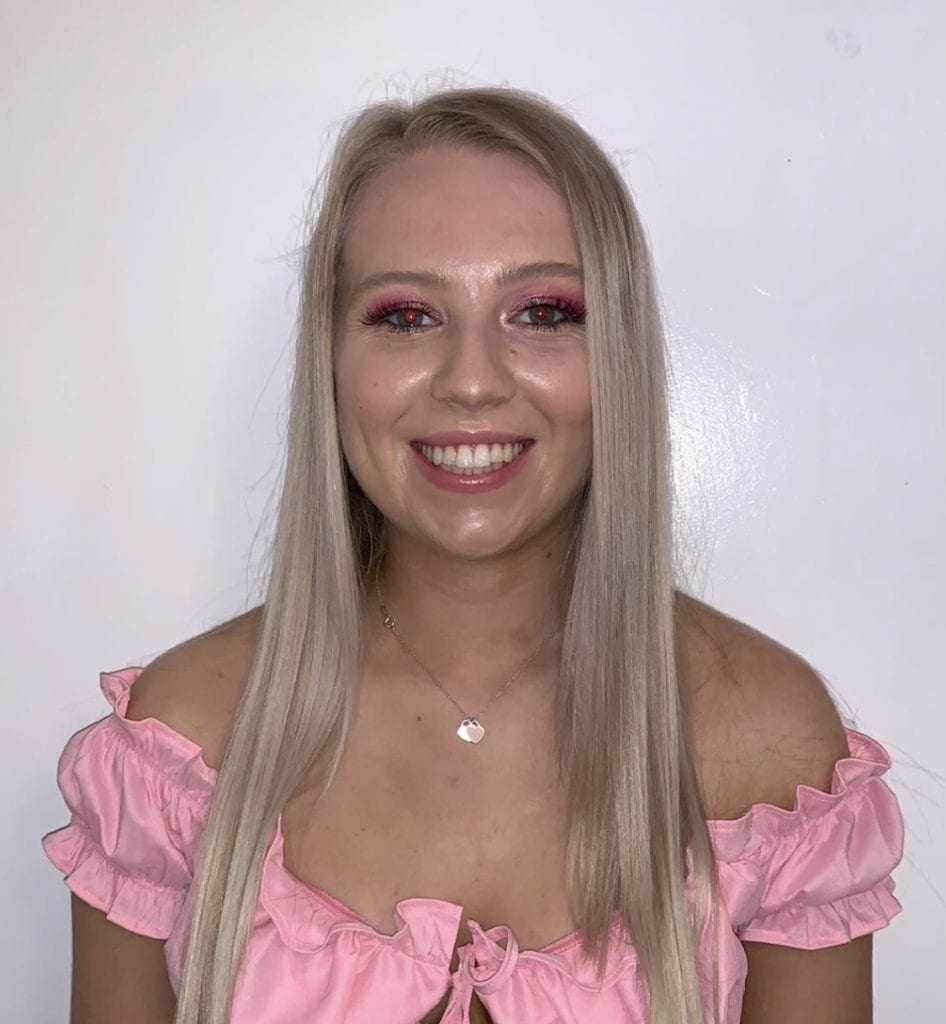
Emily Robbins
University of Northampton
My Final Major Project concept is about the serious issues of homelessness and mainly focuses on people’s everyday day experiences of life on the streets. For my research, I travelled around the streets of my home city of Leicester to try and understand what life is really like living on the streets through my interviews, I gained a better understanding of what it’s like to live on streets. I want people to notice my work and get the conversation started around the subject of homelessness through my textile/fashion collection and especially through my specialism of printed textiles.

Becky Fowell
Nottingham Trent University
Inspired by the women on our screens in ‘90s/early 2000s film and TV, we watched as the iconic ladies of this era took on life and demonstrated that it isn’t always perfect. However, I find myself in the position where I am now also navigating my twenties and ‘taking on the real world’ can at times feel overwhelming. I wanted to build a collection which helps a young woman through this time in her life, whilst feeling empowered, sexy but comfortable all at the same time. My designs blur the lines between comfort and elegance. They’re a response to the uprise of ‘working from home’ and the likely loosening of future working dress codes. I have in turn created athleisurewear which can suit either ends of a working woman’s life- both professional or more casual environments.
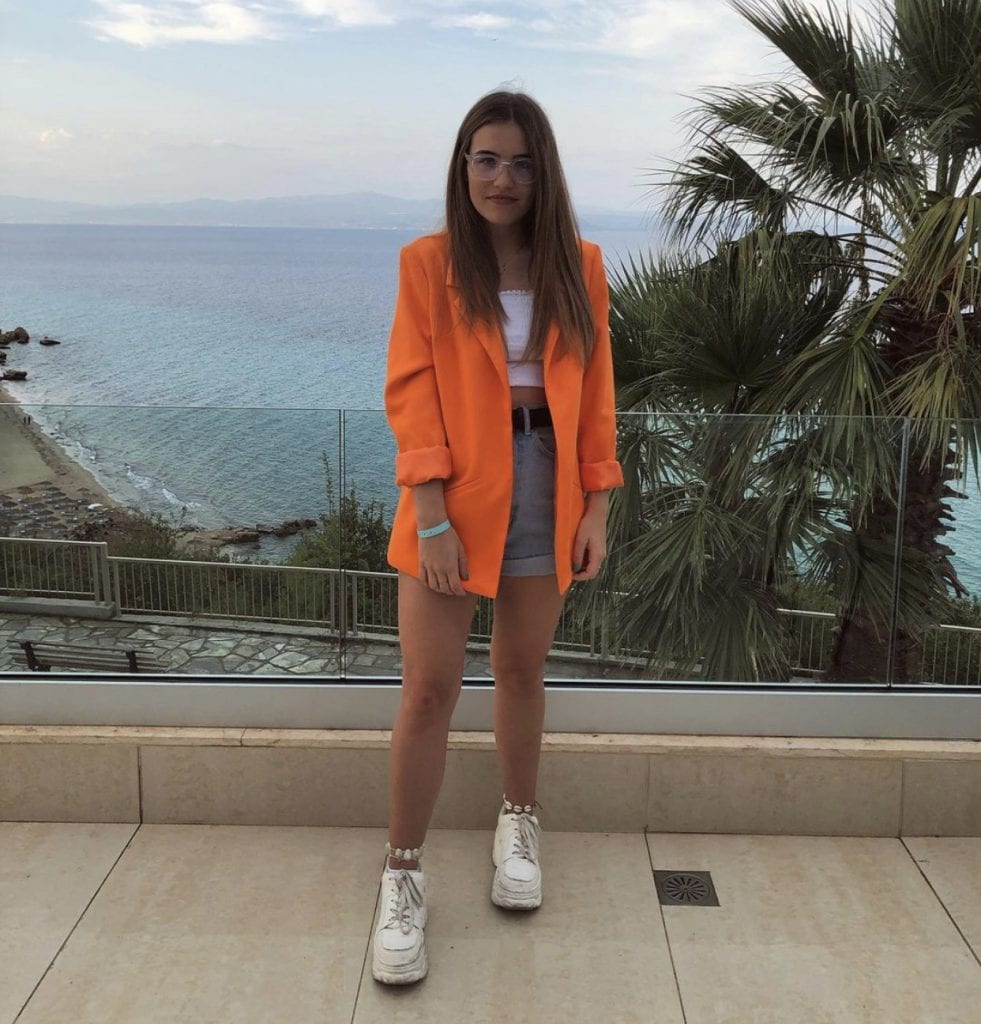
Leah Thompson
Nottingham Trent University
Doping is used to create the enhanced rush and power that the individuals think they need to exceed their limits. This inspired me to create an inclusive collection that gives them a comparable feeling without the substance. I focused on the lack of social inclusiveness for people with disabilities within the sporting industry and want people to realise that the only limit is their mind. I have ensured my designs are removing the barriers between the fashion world and the life of someone with a disability through fastening and adjustable aspects to create an inclusive, limitless society.
The Commercial Design Award

Paulina Golovasovaite
De Montfort University
Daelunn is a one-of-a-kind and sustainability orientated fashion brand. “The Opulent Scent of Ancient Egypt” is the theme of the collection. The culture of Egypt and the imprint of ancient history are the main sources of inspiration for the capsule collection. Selected colour palette consist of lapis lazuli, carnelian, black onyx, and turquoise, which are among the most commonly used precious stones for decoration in Egypt. Only recycled and organic fabrics have been used in the capsule collection. Capsule Collection’s signature outfit is a co-ord set consisting of a Cropped Top, Asymmetrical Edgy Shoulder Blazer, and High-Waisted Shorts with Flap Pockets.
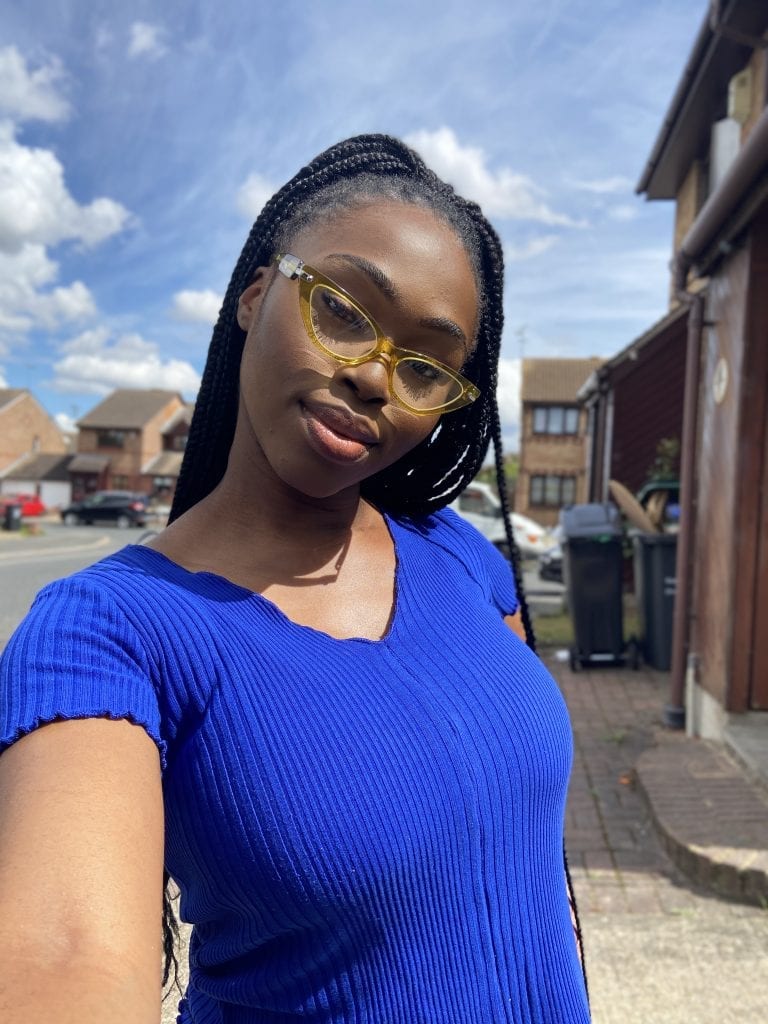
Jemima Jacob
De Montfort University
The word ‘post’ always prefixes an event – it introduces the reaction. Throughout history, you’ll find that culture, music and clothes have served as the perfect channel to do just that.
My theme of sartorial streetwear is drawn from the 20th century subcultures of British Mods, Jamaican Rude boys and the genre of 2 tone ska. I have married their style and symbols with the millennial male customer to create an aesthetical and informative collection.
Dominica Buonasorte
University of Derby
My concept Remake is an online sustainable fashion retailer with a fashionable twist, my USP is all brands which are stocked on the website only manufacture in the UK. I have a created an additional personalised upcycle service available on the website, which specialises in natural dyeing made from plant based ingredients. The consumer will have the choice to pick which colours and dyeing technique they would like which will be arrange over on my website. I have used social media, a promotional festival bundle and PR packages to promote my brand to attract conscious and fast fashion consumers.

Sofie Nikl
University of Derby
This project aimed to establish a conscious slow womenswear fashion brand called Nikl Studios. The brand’s primary focus is to create a concept that enables consumers to make responsible buying decisions. QR codes are investigated throughout to achieve high product and brand transparency. A website is built for the brand to implement the product information, which appears once the customer scans the unique QR codes sewn into each clothing item of the brand. Within the project, a fashion collection has been launched, matching the brand’s aesthetic and values. Creating a change for the better with every small decision taken.
Rachel de Souza
University of Huddersfield
Shibori a universal term, is the Japanese word for manipulating fabric before dying. The technique is not unique to Japan alone. The ability to create patterns by manipulating fabrics is a technique that also adopted by many cultures. Africa has a strong connection of tied and stitch resist dyed textiles. In Nigeria shibori is known as Adire, which is a technique that is perfected and passed on generation after generation. This commercial collection aims to celebrate and bridge the gap between two cultures that thrived off this technique in the past, demonstrating the diversity in today’s generation and highlighting the similarities shared in the textile’s history.
Madeleine Sugden
University of Huddersfield
Sisterhood is a high-end collection designed by women, made by women, for women. Influenced by the art of tattooing, to make a statement in opposition to the exploitation of tattooed women, breaking the stigma that women with ink are unprofessional and have looser morals, often branded with the term ‘tramp stamp’.
As a young, tattooed woman, I have personally felt the judgement and mistreatment of choosing to show myself in a certain way.
All garments in this collection are meticulously designed to last throughout seasons. The quality of the garments prolongs their lifespan. Everything about Sisterhood is against throw-away fashion.
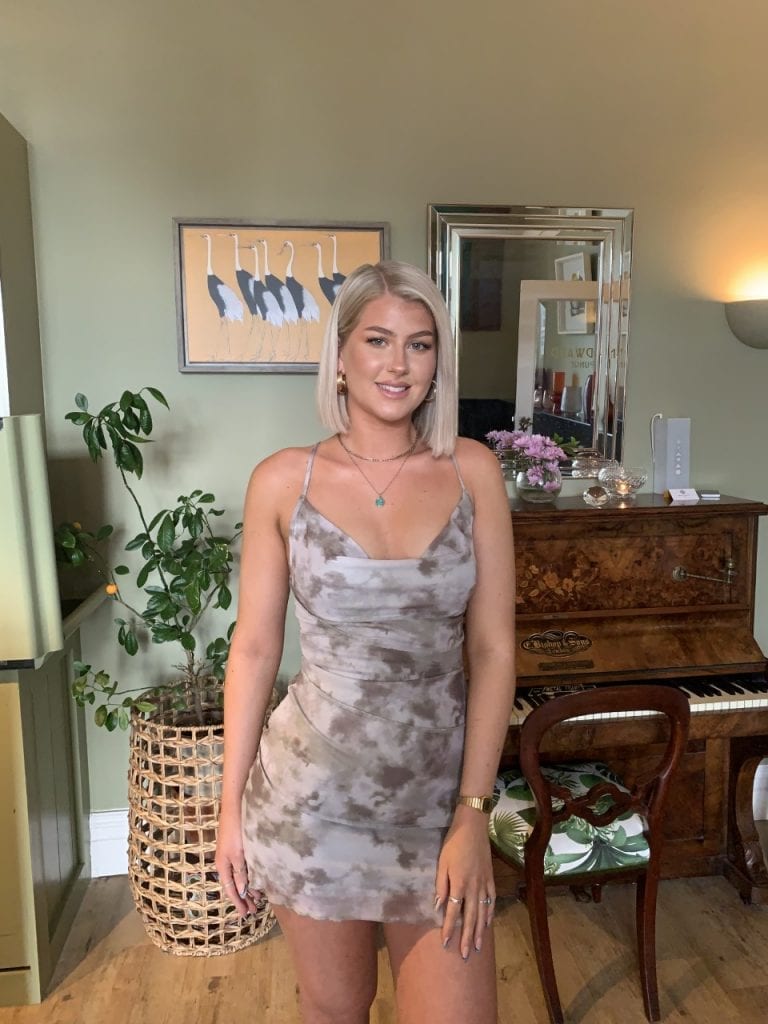
Natasha Finlay
University of Northampton
My concept for my final major project is based on dreams as I have always been fascinated by dreams. I keep a dream journal and had noticed that since the COVID-19 pandemic, I had been having strange dreams in the first lockdown I took to social media and asked everyone if they were experiencing the same change in their dreams as me.
I asked all my social media contacts to share with me their own dream experiences and I received over 100 different messages from people detailing their personal dreams during the first lockdown. They ranged from sleep paralysis, nightmares and psychedelic dreams.

Georgie Lee
University of Northampton
My FMP is based on the idea of surrealism. This post war art movement in 1920’s, aimed to change the perceptions of the world by exploring dreams, the unconscious mind and the irrational. Surrealism was believed to be a way of the escaping the harsh reality of the aftermath of the war by denoting to happier places. This idea of escaping is still relevant now but for different reasons. I will be creating a surreal world inspired by childhood associations, a time of pure blissfulness, to provide an escape into imagination. Whilst referencing skiing, my biggest escape.
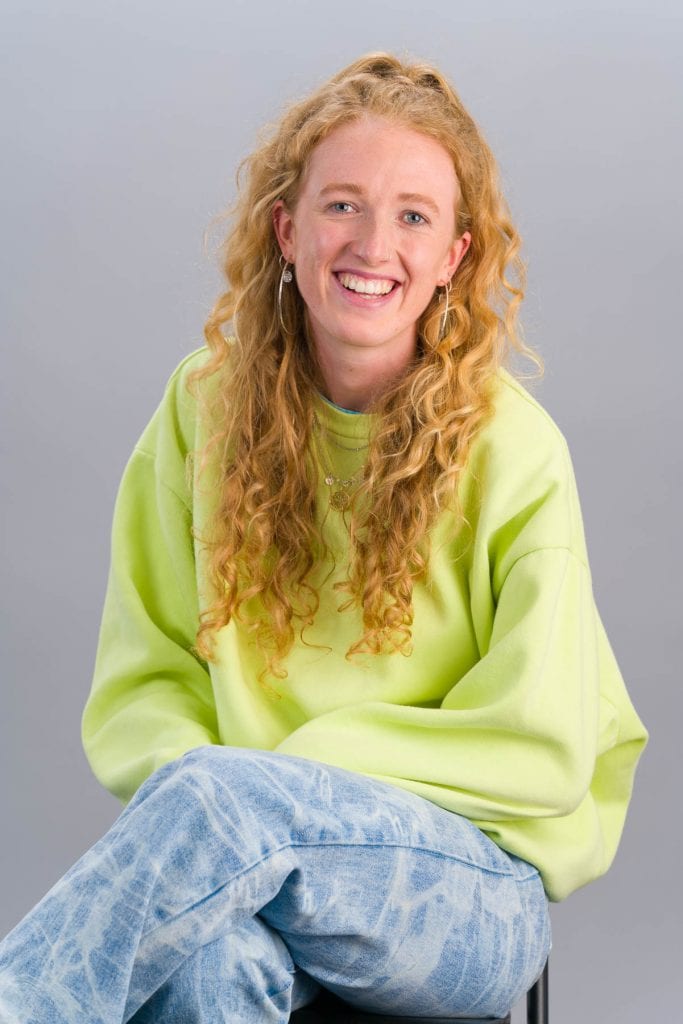
Sophia Marshall
Nottingham Trent University
When the world ground to a halt in 2020, as did the things that bring excitement to life. The days of dancing carelessly with friends in tightly-packed clubs became a distant, yearned for memory.
I Like Large Parties is a collection intended for the celebration of our united and exciting post-pandemic lives. Referencing the Roaring 20’s through family photographs, old jewellery and classic literature, this collection draws from the past, to celebrate the future.
Intended for a high-end unisex streetwear market, with strong emphasis on graphic embroidery and hand- embellishment, I Like Large Parties is inclusive, exuberant, and completely joyful.
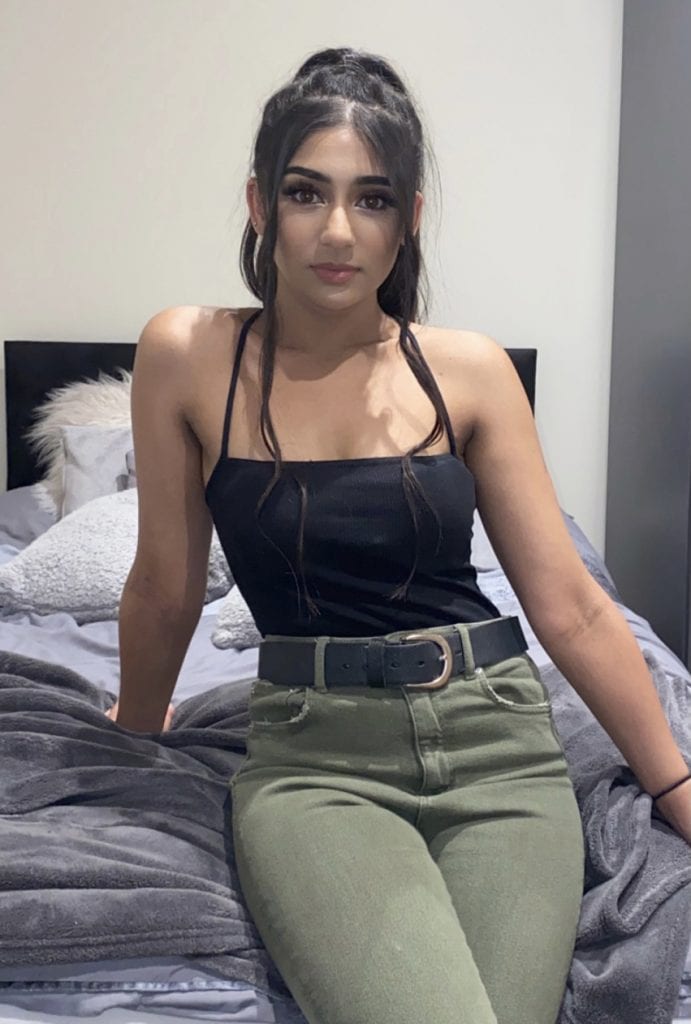
Shweta Vakharia
Nottingham Trent University
Despite there being several facilities to assist anxiety sufferers, I wanted to shift my focus towards designing products that would relax the user personally. I created inclusive products that aid wearers from feelings of distress, through the combination of practical yet creative elements. This has led me to include features such as soft fabrics, replaceable pockets, and bar codes directing users to a calming playlist. Relievers such as an opening within the sleeves allow ventilation, and tightening features, text, and weighted fabric are further support mechanisms within the jacket.
The Footwear & Accessory Design Award
Grace Anderton
De Montfort University
For this project, I wanted to create a range of shoes for a market I have not designed for before. I was inspired by both my parents, who commute to work every day. They find that cycling benefits their physical and mental health. In addition, cycling decreases their carbon footprint and reducing the cost of fuel per month. My designs are inspired by green architecture, which is an approach to building that minimises the harmful effects of construction plans on human health and the environment. The architect attempts to reduce environmental impact by choosing eco-friendly building materials and construction practices.
Lucy Roberts
De Montfort University
My designs were inspired by the ‘Quagga’, an animal that displays characteristics of a horse, zebra, and donkey. This sparked the idea of a brand DNA that consisted of 3 different things, activity, category, and technology, that would come together to create something new. I chose wake skating as my activity, which is a relatively new sport and is based around skate and wake boarding. My category was high-end runway shoes and the technology I incorporated was control fulcrum. These 3 things came together to create a collection of beautifully unique designs all sharing a trademark outsole inspired by surfboards.
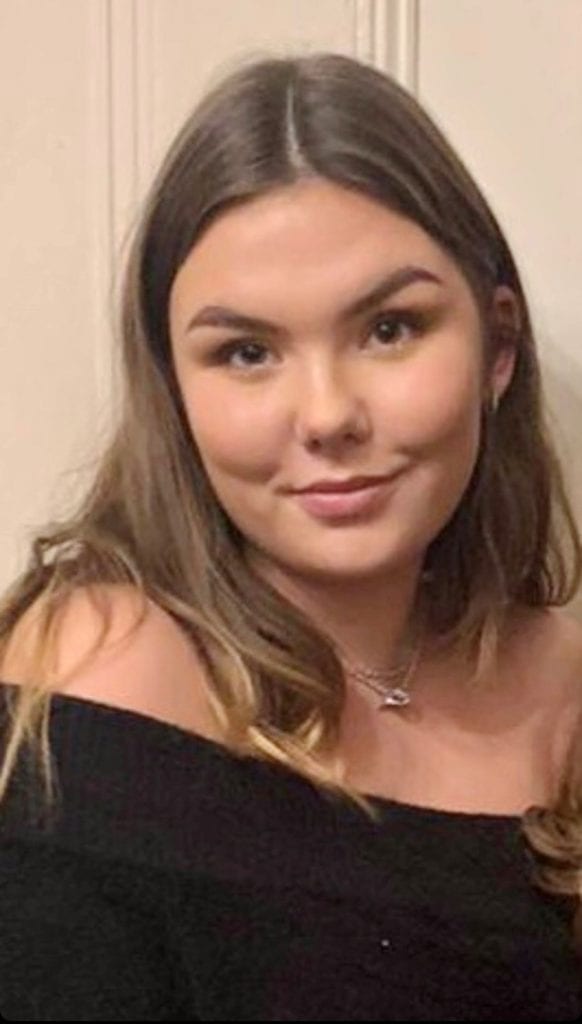
Georgia Alligan
University of Derby
The concept of ‘Seed Dispersal’ explores the natural forms of seeds, highlighting the soft and curved shapes associated with them. Seed Dispersal is an adaptive mechanism in all seed-bearing plants, participating in the movement of seeds away from their parent plant. The key word of ‘movement’ became a focus, leading to exaggerated curved shapes gaining a sense of freedom and fluidity throughout my work. Testing and development led me to explore 1970’s interiors, focusing on bold waved graphics. This led to a collection of knitted garments and bags that create a particular aesthetic inspired by retro and handmade trends.
Nicolle Drieu
University of Derby
The concept for my collection was creating textiles beyond their traditional use of fabrics and instead producing woven and knitted forms that are tied to the body, creating bespoke layered accessories. By embedding structure into the textile such as acrylic circles or wire coated in a foam layer, it becomes possible to explore 3D shapes within weave and knit establishing textured fabrics to layer and manipulate. I was inspired by utility styled clothing, as it creates layered forms that exaggerate body proportions, playing with scale. Creating an accessory that is adaptable and challenges the stereotypical structure of garments.
Sophie Hall
University of Huddersfield
The inspiration behind my accessories line is the working-class, looking at what people wear, the functionality and using these details to create new and fashionable and practical items. The bucket hat was originally used by fishermen, adapting into the modern fashionable hat, and the bags (rucksack and tote) being common bags used in day-to-day life. The line runs alongside my final collection and was created from waste fabrics due to the unique shapes of my pattern pieces, and offcuts from pattern matching. Due to this, all items are sustainable, and have weatherproof qualities suitable for autumn/winter.

Charlie Irwin
University of Northampton
A project that started as my interest in outer space and making a home elsewhere, made me turn my attentions back to home, and how it more than ever needs our help, rather than to flee from it. I felt the urge to leave Earth say a lot to me about civilisation’s constant worry about its fate. Worry that is rightly placed when looking at current events. I attempted to do this through sustainable practices such as reusing and upcycling, taking abandoned and damaged outdoor waste like sleeping bags, tents, wetsuits and other equipment, and turning it into product.

Jen Bradley
University of Northampton
We need to act now to save our Amazon Rainforest for our future generations. In June 2020 Greenpeace recorded 2 248 forest fires, a 20 percent increase from June 2019, the largest recorded number since 2007. This destruction puts the lives of 10 million animal species and ingenious tribes at risk, with nowhere to call home.
Tropical Madness is a genderless kids collection for young explorers aged 3 to 7. The collection is a minimal yet funky celebration of the animals who live in the rainforest who aren‘t currently endangered but will be if the destruction continues.

Natasha Finlay
University of Northampton
My concept for my final major project is based on dreams as I have always been fascinated by dreams. I keep a dream journal and had noticed that since the COVID-19 pandemic, I had been having strange dreams in the first lockdown I took to social media and asked everyone if they were experiencing the same change in their dreams as me.
I asked all my social media contacts to share with me their own dream experiences and I received over 100 different messages from people detailing their personal dreams during the first lockdown. They ranged from sleep paralysis, nightmares and psychedelic dreams.

Kwok Hei Tung
Nottingham Trent University
I would like to brings out nostalgia is a sense of security to let us always can rely on, therefore I transformed it from subconscious to actual designs related to protection. Screening out the truly special things that spur to myself which draws on Hong Kong culture, the corner house. From this research I gathered shapes, patterns to take forward into my designs. My overall collection shapes are sticking out mixed with curvy surface and structured outline, contains origami element and primitive attachment method inspired from my drawings related to takeaway boxes. Metal hardware gives to modernize and complimenting tying together the finished look. For the color palate, it was referenced to trend research, retro-pastel shade coincidentally integrates the themes more with corner house wall paint.
Honor Williams
Nottingham Trent University
The concept for my final collection project was initially inspired by my DCC dissertation on sportswear and its filtration into streetwear. I was intrigued by the fetishization of the working-class subculture and how their style is adopted by luxury fashion houses. I chose to use this as my starting point and have created a collection based on class divide and structure as a result.
I began my research looking into the idea of balance in society and used the balancing of shapes and objects to inform my primary drawing. Looking further into different elements of balance, I also studied the human body and how it balances and moves during exercise. I then moved on to looking at imbalance and was mostly inspired by the crimping or collapsing of objects. I took inspiration from how clay folds and used this to experiment with the way that leather moves and pleats. The pleating of leather was the main technique and visual aspect of the overall collection.
The Knitwear Design Award
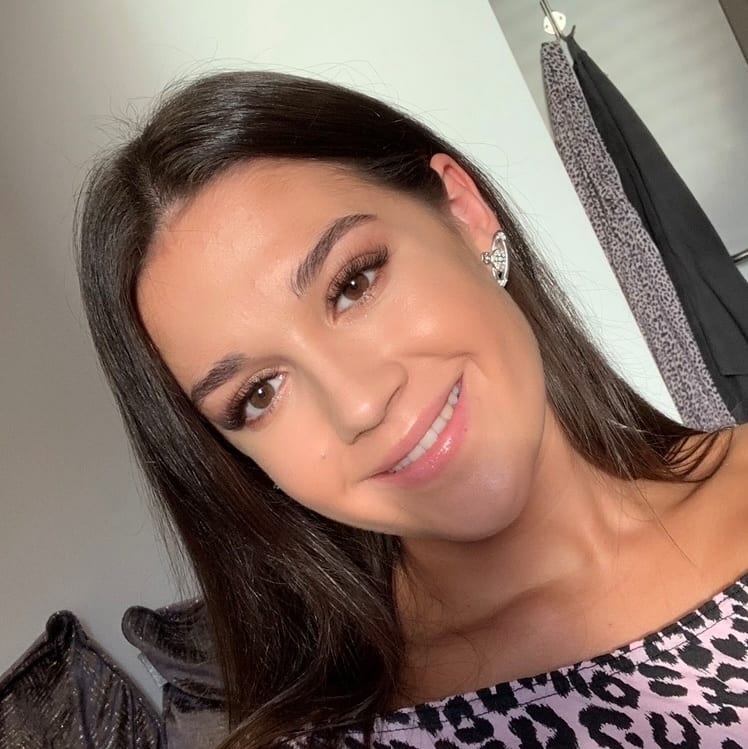
Penny Kowalkowski
De Montfort University
Forced change is a response to the restricted movement and physical interactions experienced during 2020. Physical and social interactions moving to digital platforms has resulted in a change of behaviour and shaping society. Exploring methods of recording and controlling movement influenced by the forced use tracking apps. An involuntary disconnection with society that changed how people interact. Dance and performance art visualises the intimacy of human interactions and articulates themes of dependence and tension. Using a range of creative and non-creative specialisms to inspire responses that are translated into a knitted context. The intimacy of interactions.
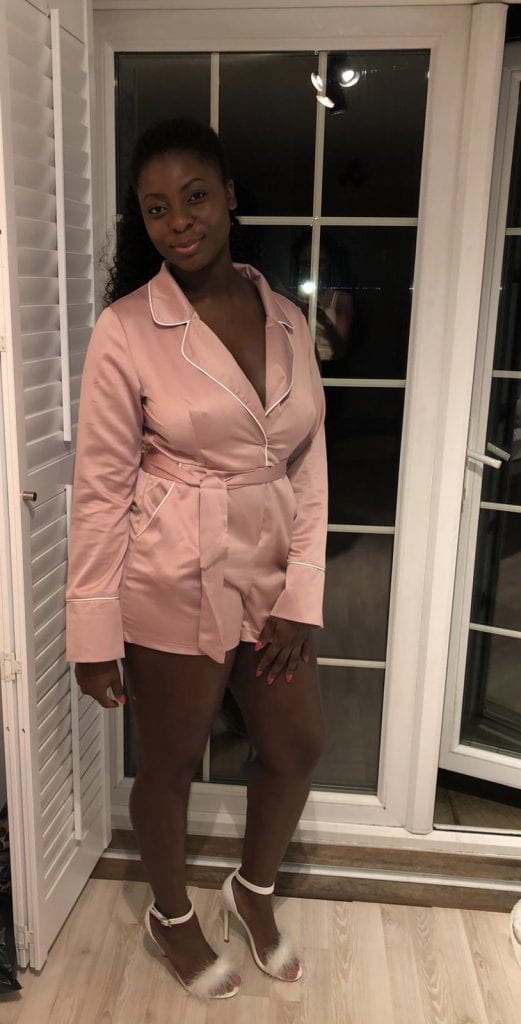
Kaya Vaughan-Walcott
De Montfort University
For my final project I wanted to be bold and celebrate who I am and my heritage through a colourful, expressive, and commemorative collection. I analysed my relationships, rituals as well as the restrictions I face. Three things stood out and became the core part of my project; plaiting my hair before bed, cultural values and being represented as a minority and the discrimination black women face because of their hair texture and hairstyles. Living with feelings of inequality, questions such as ‘do I belong’ and social injustice in being who I am became a driving force of my project.
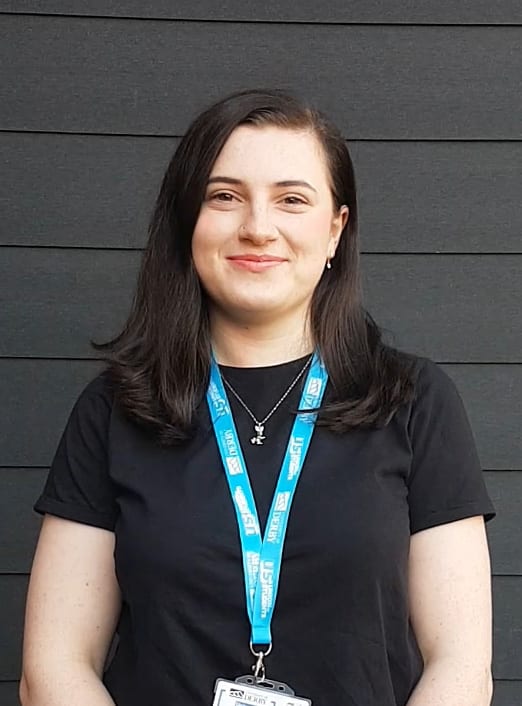
Grace Stevens
University of Derby
My womenswear collection is inspired by Henri Matisse’s cut-outs, focusing on simplified forms, finding beauty in many objects. I also took inspiration from insects and micro-biology. I emulated small repeats, shapes, and colours that I could see from these areas of inspiration when making my own cut-outs, then translating designs into knitted fabrics.
My collection has a broad, extremely vibrant colour palette, creating a fun collection of garments. Sustainability is important to me – I chose to source as many high-quality, natural yarns as I could, anything synthetic is donated, second hand or recycled to make my collection more sustainable.
Christina Swift
University of Derby
This collection was inspired by my time living in the Scottish Highlands, in a village called Glen Coe.
My interest in climbing allowed me to create a bold and bright collection that reflects the adrenaline felt when climbing. The risky designs show the danger that climbers experience while capturing the textures and business of equipment worn.
This collection reflects my personal interests and experiences and I hope that it inspires and motivates others to appreciate the outdoors, its properties and possibilities – especially during a national lockdown and see change that our society has had to endure in recent times.
Alisia Damianou
Nottingham Trent University
Within my final major project, I am exploring the substantial meaning that lays beneath the surface. Through the connection between wrinkles and values, I shaped a very personal concept that can relate to many young girls and women in the postmodern era that are influenced by the strong importance of appearance, often forgetting about their true substantial values. The concept is also translated into my own practise as a fashion knitwear designer through a sustainable statement, which revolves around postmodern consumers that are more drawn to the appearance and price of a garment than its quality and ethical production.
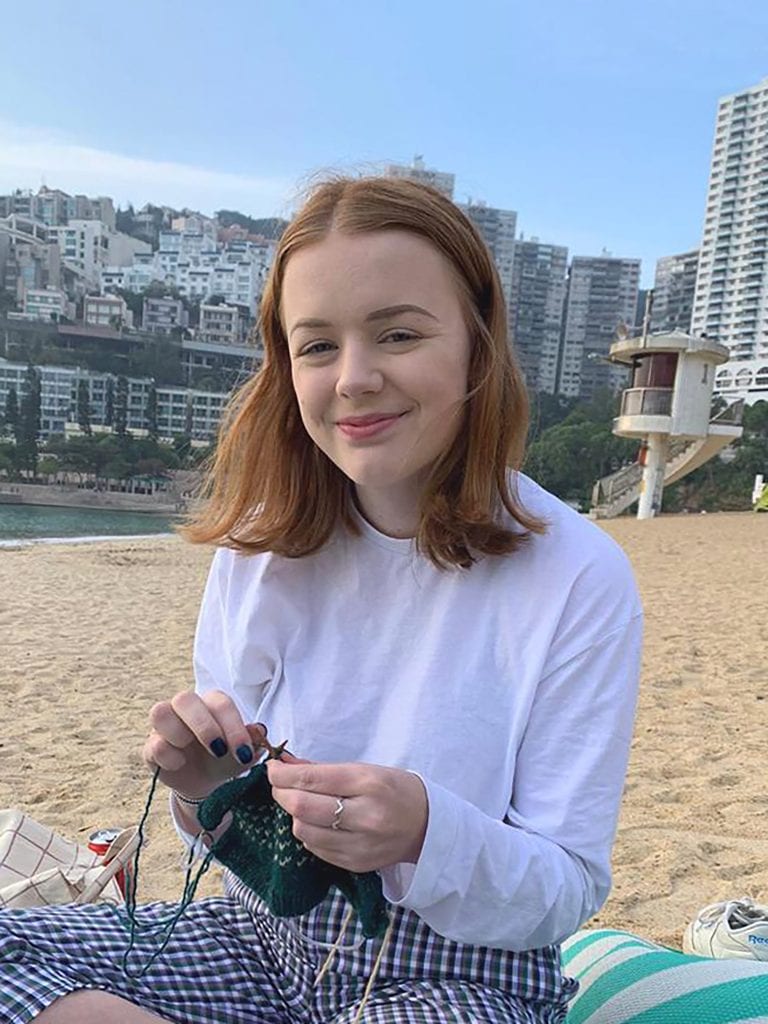
Tamsin Hackett
Nottingham Trent University
My collection explores the deterioration and contrasts within traditional craft industry environments in Hong Kong, and vanishing crafts which are struggling to keep up with modern society. This is paired with a focus on traditional, high-quality craftsmanship values as a means of creating long-lasting, meaningful pieces.
I experimented with clean, fluid silhouettes – exploring texture and movement, and structures ranging from handcrafted knit/crochet to finer draped, pleated fabrics, and bleached lace. Silks, orange and lilac shades contrast against chalkier, pastel merino. Texture is key – exploring pleating reminiscent of crafted shutters common in traditional workshops, but distorted, textured and faded.
The Menswear Design Award
Kyla Holden
De Montfort University
For my FMP “Child’s Play”, I have taken inspiration from mine and my family’s childhoods through photographs and memories. As a family we are very playful with each other, and I wanted to translate that within my sampling process by making them very fun and engaging. With my samples, I have found my base inspiration of tapestry print from my Grandma’s house and took a traditional print into an innovative direction. I also wanted to blend the relationship between knitwear and fabric together by crocheting tapestry/ paisley pattern within the fabric with bright and inviting colours.
Fanta Shirif
De Montfort University
For my final collection I have researched the concept of being Afropean and looked closely at my family’s journey in finding settlement in Europe as Africans. Focusing on my dad’s experiences, I’ve looked into his interest in football, his time playing for the PSV Eindhoven national team, and that aided him significantly in finding a sense of belonging in the world. No matter where he was, whether he could speak the language or not, he could always find a relationship with people and places through the sport. From this I began investigating the crossovers between football and my African heritage.
Olivia Noble
University of Derby
No more silence is a menswear collection spreading the narrative of racial oppression and injustice, specifically looking at how the UK is not innocent. Many people are oblivious to racial oppression within the UK and believe it only happens in America and so not our problem. My project is not only to show support for the Black Lives Matter movement but also to raise awareness on our nations part to play in slavery, police brutality, how racial injustice is integrated into politics and housing.
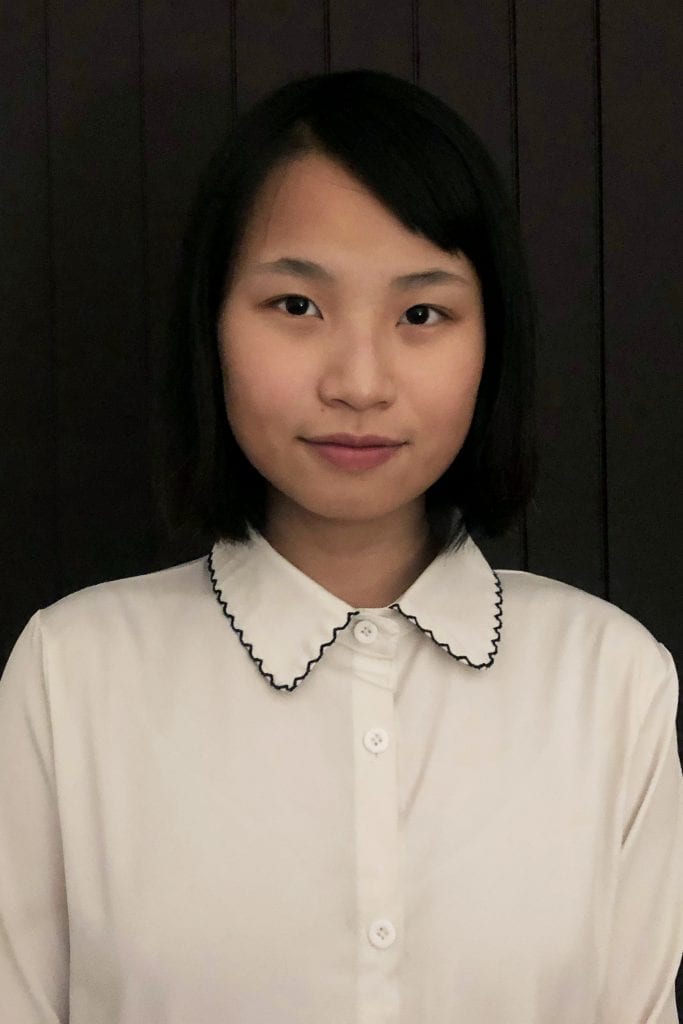
Anika Vo
University of Derby
For my final major project, I decided to explore the cinema of Wong Kar Wai. My initial inspiration started with one of his movies called “In the Mood for Love” which tells a story of two married couple trapped in a loveless marriage and in the political changes that Hong Kong was going through in 1960s.
A place where East meets West and Capitalism meets Communism. In my project I explore early stages of its rare identity, where the locals started to adopt western clothes and customs and make it their own with a traditional twist.
Sophie Hall
University of Huddersfield
The inspiration behind my collection was the working-class community within my city of Wakefield. I looked at urban decline and dereliction in the streets due to neglect and underfunding to inform my designs’ silhouettes. The key features of this collection are the practicality and functionality of garments, which came from photographing typically working-class clothing and uniform to gain more knowledge on the key details and fastenings. The bold print was designed by creating artwork based on the lettering on banners and signs used in the miners strike protests during the 1980s.
Isabella Irving
University of Huddersfield
2965 defines its’ concept in one word – Equal. By bringing past and present elements of the west Yorkshire police force with world current climate and affairs captures equality within race and push the barrier within fashion. A collection designed for anyone, no matter who you are – we stand together.

Natasha Finlay
University of Northampton
My concept for my final major project is based on dreams as I have always been fascinated by dreams. I keep a dream journal and had noticed that since the COVID-19 pandemic, I had been having strange dreams in the first lockdown I took to social media and asked everyone if they were experiencing the same change in their dreams as me.
I asked all my social media contacts to share with me their own dream experiences and I received over 100 different messages from people detailing their personal dreams during the first lockdown. They ranged from sleep paralysis, nightmares and psychedelic dreams.
Jonathan Goddard
University of Northampton
My concept challenges the social aspects a new futuristic City. Akon city will stand tall and lead by example for the sister counties of Africa. Invested by Arabic investors, it’s easy to say the consumers of this city will need to be rich and wealthy in order to enjoy the lavish lifestyle the city has to offer.
It understands the experiences Senegalese people may endure by reflexing my attention to how Dubai is constructed and till this day still use exploited workers. Low-income wages, cramped rooms for pioneers of the richest city provides a real insight on possible life for the local communities.
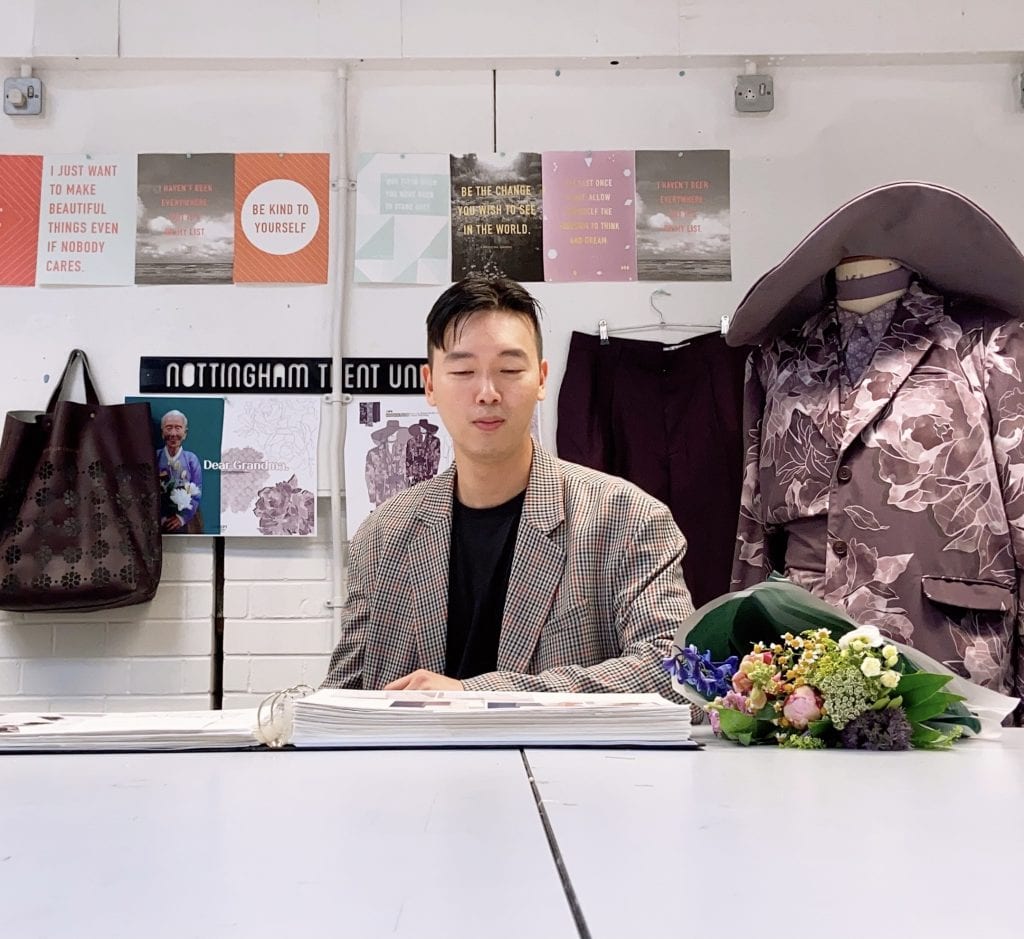
Kyle Jeong
University of Nottingham
I focus on my personal stories and cultural elements for this graduation collection. “The most personal is the most creative.” Martin Scorsese. Therefore, I did a personal primary research on my grandmother. The mood, colour, silhouette, and printing ideas of the overall collection were inspired by the appearance of Korean society before the 1950s, in which a beautiful harmony of Eastern and Western culture as Western culture came into Korean culture. Developed innovative silhouettes through collage and stand work as hundreds of design processes. So that, my concept and collection into one through research on balance of the overall collection.
Dona Thambi
University of Nottingham
My concept is derived from the architectural structure of City Palace, located in Jaipur, India, which reflects a mix of European and Mughal architectural style in fusion with the Victorian women who wore suits as a symbol of power and equality. I am using the architecture of the palace with the trims and details of the suits to create a much more contemporary unisex collection. The idea is to blend Indian architectural heritage and British tailoring into something more contemporary.
The Sustainability Award
Madeleine Ryall
De Montfort University
When deciding the concept for this collection I looked more at me and my life rather than anything else. So, I looked at who I am and why I am here and that took me back to my very own cool granny.
My granny is still very much an inspiration throughout. However, since being back at uni and having chats with my lecturers, the research I have conducted has been looking at the misconception of older people and trying to break down those stereotypes because isn’t everyone “cool” in their own way no matter their age.
Harriet Wiltshire
De Montfort University
My concept is all to do with the game of netball as I have played netball ever since I can remember. As a designer I try to be as ethical and sustainable as possible through sourcing environmentally friendly fabrics or upcycling second-hand garments. I have created this collection from upcycling netballs and netball equipment using bibs, laces and netballs. I have sourced these materials through schools, sports teams, gyms, netball manufacturers, Facebook Marketplace and eBay. I have been able to give these materials a new life in a wearable and fashionable collection instead of them just being thrown into landfill.
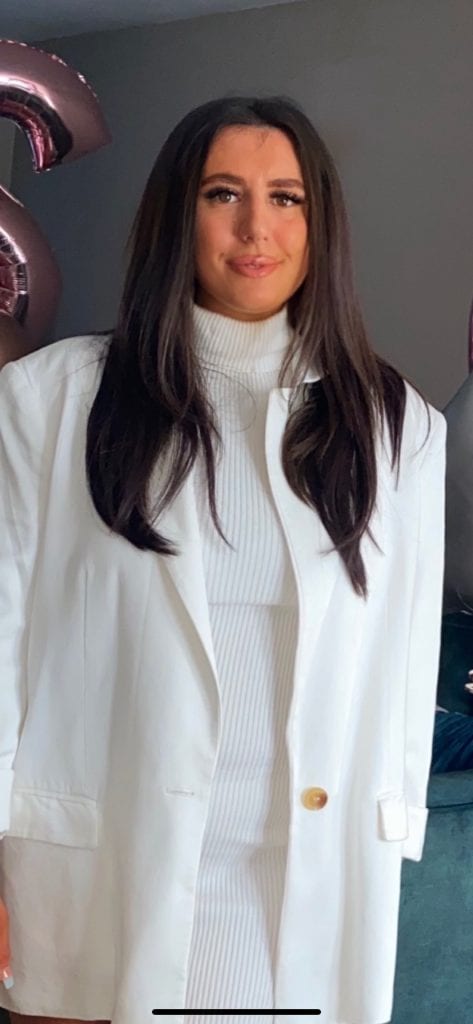
Dominica Buonasorte
University of Derby
My concept Remake is an online sustainable fashion retailer with a fashionable twist, my USP is all brands which are stocked on the website only manufacture in the UK. I have a created an additional personalised upcycle service available on the website, which specialises in natural dyeing made from plant based ingredients. The consumer will have the choice to pick which colours and dyeing technique they would like which will be arrange over on my website. I have used social media, a promotional festival bundle and PR packages to promote my brand to attract conscious and fast fashion consumers.
Abigail Wales
University of Derby
Abandoned fishing gear is the most common plastic found in our oceans. I wanted to use my work to inform people about the threat oceans are currently facing and to demonstrate the beauty and possibilities of reusing materials. The woven samples are designed to be one off bespoke art pieces created to draw attention to the issue of ocean waste. The fabrics are created to allow them to be deconstructed, separating the elements to then be reused or recycled at the end of the product life.
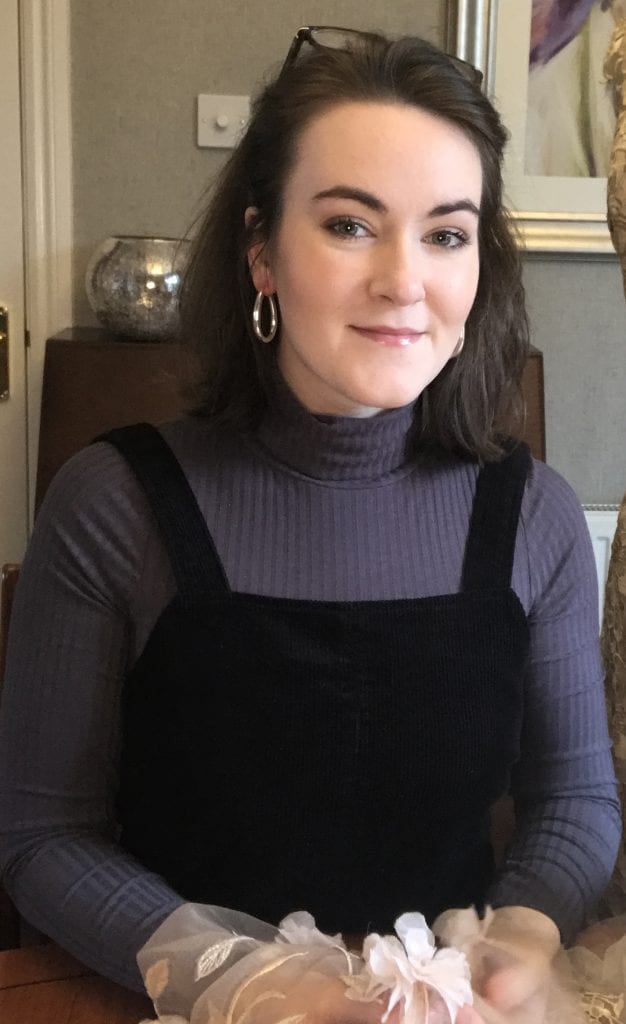
Megan Gardner
University of Huddersfield
A sustainable Wedding Veil collection, using artisan handcrafted elements to highlight the potential for sustainable practices in the bridal industry to push for a more sustainable sector. All fabrics and trims used have been repurposed and recycled from previous projects or bought second hand from platforms such as eBay and charity shops.
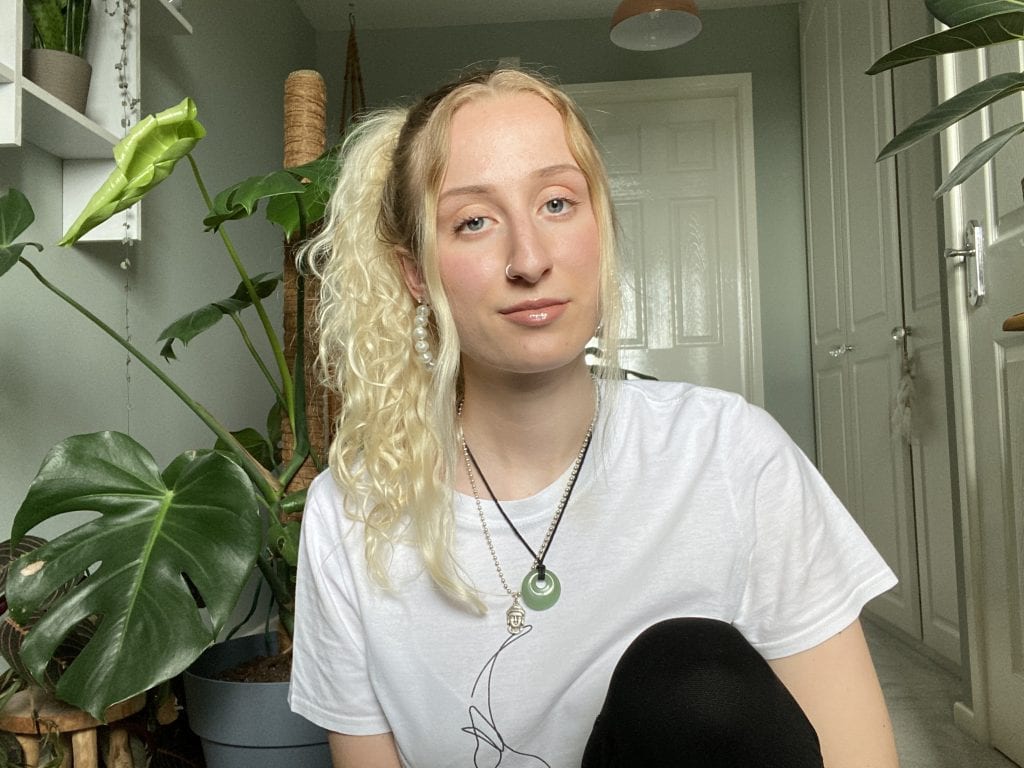
Cerys Jones
University of Huddersfield
Imitation jungle is a womenswear AW21/22 collection designed with a strong environmental ethos which acts as a focal point throughout the collection, presenting itself as an environmental campaign through textile artwork and visuals in the form of portraiture and campaign slogans. This intends to represent the voices and frustration of the younger generation regarding current issues surrounding the planet. The inspiration for the collection is based around urbanization and how our current younger generation have responded by “bringing the outside in” to create own unique “urban Jungles” with tropical houseplant styling, evoking a sense of calm, compensating for diminishing landscapes.
Iona Beresford
University of Northampton
The Greatest Sacrifice –
Being raised in a strict Christian commune which many people, including the media, have labelled as a cult means I am navigating life, with a new perspective. I have used C.S Lewis’ book ‘Till We Have Faces’ as direct inspiration for my designs as within the book, the focal family cannot escape the confines of their home. The use of upcycled interior furnishings and natural dyes produced from the home i.e. food and garden waste reflects how we had to sacrifice a great deal of materialistic goods- this strongly emphasises the sustainable concept within my project of zero waste and upcycling.

Chloe Cooper
University of Northampton
My sustainable collection is titled ‘A Place’ and stems from themes of paradise to create a place of belonging, a space to be truly yourself and to celebrate life for what it is. I have created interchangeable garments that allow the wearer to adapt themselves, giving them full autonomy over their body and expression. My collection uses innovative construction techniques to allow garments to become multi-functional and adaptable. I have carefully sourced deadstock and recycled materials to give new life and function to fabrics. My collection emphasises the need for interchangeable garments to increase wearability and longevity of clothing.

Katie Cikara
Nottingham Trent University
In the exploration of an embodiment of illegal rave in the 90’s with the corresponding demand for rebellion in the beginning of the pandemic. Designing a bespoke menswear collection, I aim to embody the energy with pattern clash and an experimental fluidity of motifs, that separate the beigness of casualness worn in the pandemic, challenging a versatility of tailored customisation, celebrating the baggy silhouette worn within the Manchester scene. Emotional durability and low waste slow fashion is at the heart of my design interest, to stand out and wear an item you customised yourself.
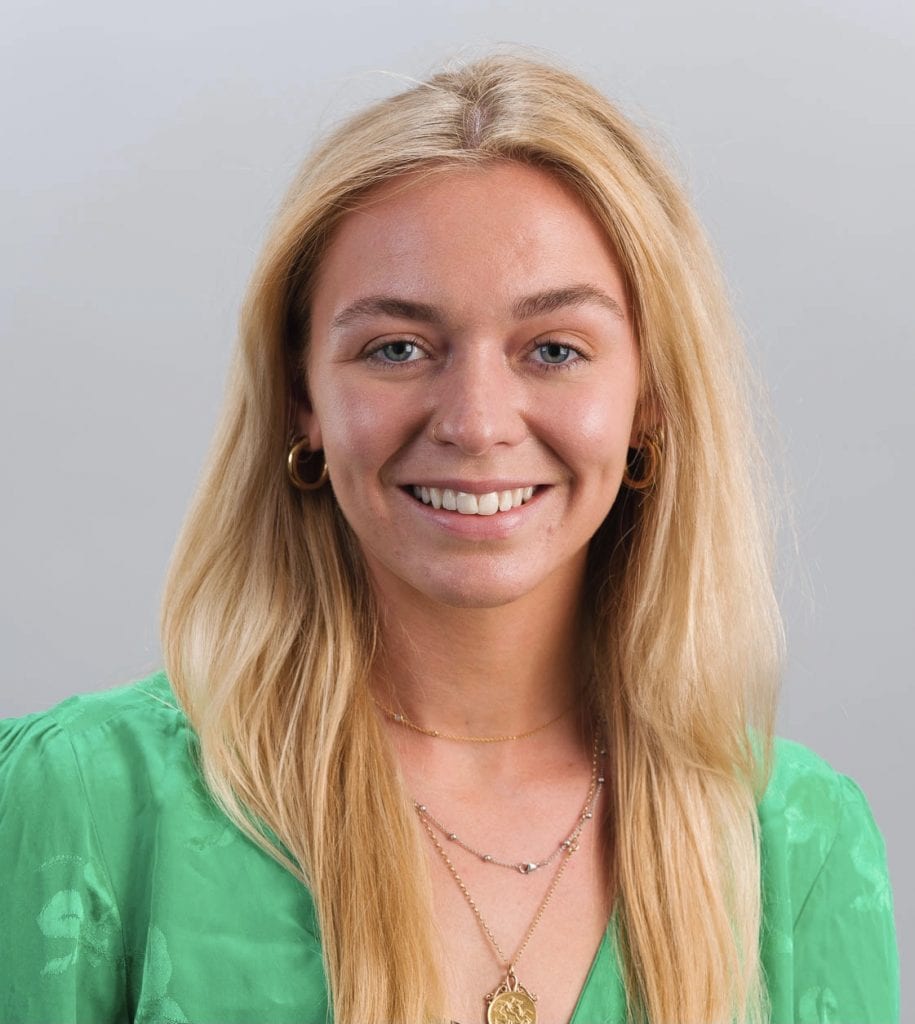
Francesca Morgan
Nottingham Trent University
Exploring the human relationship with nature, looking at constructive and destructive aspects. I wanted to encapsulate my research through a timeless and environmentally conscious collection. Inspired by an extinction rebellion protest, I explored the destructive impacts of over fishing on marine ecology and the impacts of the industrial revolution. Contrastingly, I also looked at natural artists and sculptures creating art with nature. My collection uses zero virgin resources, using only second hand, deadstock, recycled fabrics and components. It is also absent of any artificial colouring, using only undyed natural fabrics.
The Textile Design Award

Bethany Edgar
De Montfort University
The title of my project is called The New Era and represents the changes within the fashion industry and how they have been adapted and regenerated for new markets. The aim of the collection was to create a women’s autumn winter fashion collection inspired by the Elizabethan Era with inspiration taken from Tudor Architecture. Rich, decadent embroidery has helped maintain a couture feel yet is symbolic to the garments worn by Queen Elizabeth I. The collection is contemporary yet reflects the Era, though, techniques, colour, and silhouette.
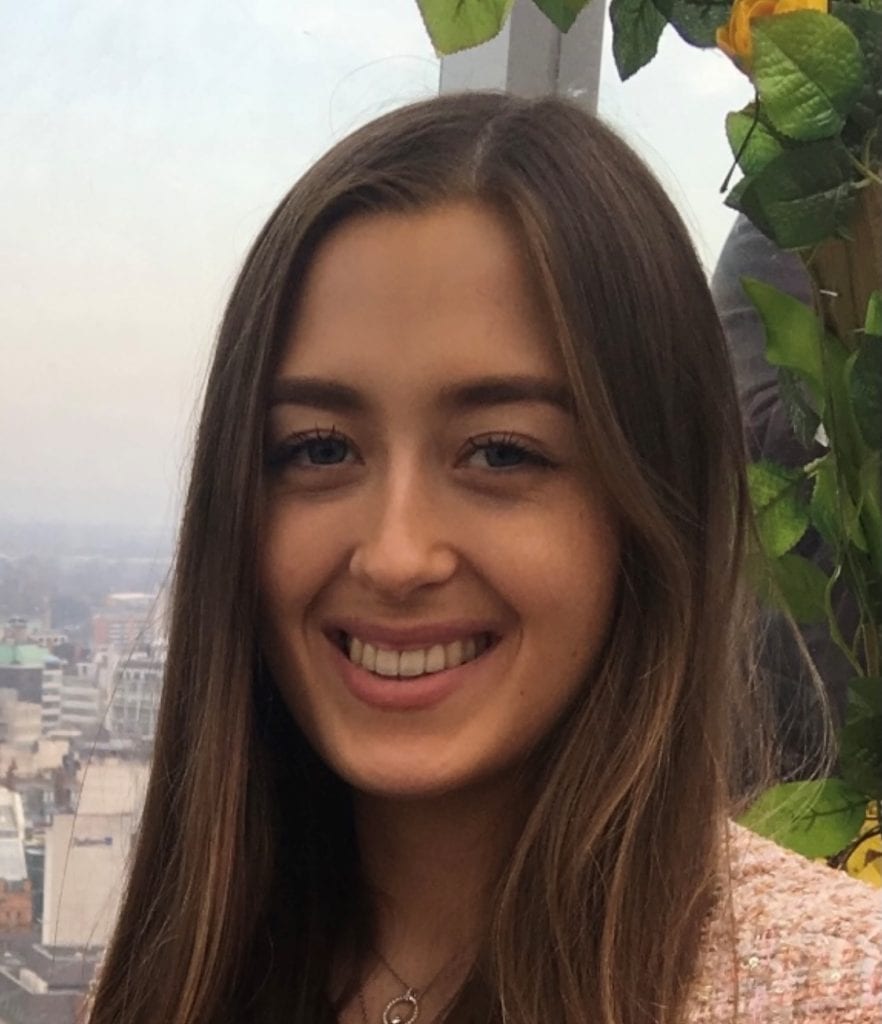
Alexandra Weatherby
De Montfort University
My project examines the perception of colour, focusing on how the layering or transparency of colour can alter the signals between the eye and brain. Exploring how the interaction of colour can distort the visual hypotheses that are made during the physiological connection between seeing and perceiving. Observing how the placement of colour can distort perception, also known as ‘optical mixing’.
Inspired by ‘Synaesthesia’ and the merging of the senses. The simulation of one sense causes an involuntary reaction in one or more of the other senses. The notion of senses ‘merging’ informed the idea to hand dip-dye my knitwear.
Jessica Boateng
University of Derby
The concept behind this textile design collection illustrates the self-discovery of my African identity within the Tropics. Linking my heritage with its habitat embodies my cultural appreciation in an authentic way. Observing Arts & Culture from the V&A, Frida Kahlo, Henri Rousseau, etc. was convenient to explore historical and cultural influences.
Based on the pressures of the Covid-19 pandemic, this collection is suitable for any home product because it demonstrates an invigorating and upbeat aesthetic. By bringing the Tropics indoors when being restricted to travel, it will allow us to create a safe and cultural experience during these unprecedented times.
Kirandip Kaur
University of Derby
My work is based on the theme of Rangoli, this theme is something that is close to my religion and heart. Rangoli is a temporary folk art from India, used to decorate the ground in front of houses and places of worship.
There are two types of Rangoli, previously I have based ideas on Form Rangoli, which includes simple shapes. However, I was inspired to develop this theme by using Ornamental Rangoli this semester, which includes patterns such as flowers and nature. I have used an eclectic mix of yarns to express the detail in Rangoli designs.

Megan Gardner
University of Huddersfield
A sustainable Wedding Veil collection, using artisan handcrafted elements to highlight the potential for sustainable practices in the bridal industry to push for a more sustainable sector. All fabrics and trims used have been repurposed and recycled from previous projects or bought second hand from platforms such as eBay and charity shops.
Madeleine Sugden
University of Huddersfield
Sisterhood is a high-end collection designed by women, made by women, for women. Influenced by the art of tattooing, to make a statement in opposition to the exploitation of tattooed women, breaking the stigma that women with ink are unprofessional and have looser morals, often branded with the term ‘tramp stamp’.
As a young, tattooed woman, I have personally felt the judgement and mistreatment of choosing to show myself in a certain way.
All garments in this collection are meticulously designed to last throughout seasons. The quality of the garments prolongs their lifespan. Everything about Sisterhood is against throw-away fashion.

Natasha Finlay
University of Northampton
My concept for my final major project is based on dreams as I have always been fascinated by dreams. I keep a dream journal and had noticed that since the COVID-19 pandemic, I had been having strange dreams in the first lockdown I took to social media and asked everyone if they were experiencing the same change in their dreams as me.
I asked all my social media contacts to share with me their own dream experiences and I received over 100 different messages from people detailing their personal dreams during the first lockdown. They ranged from sleep paralysis, nightmares and psychedelic dreams.

Emily Robbins
University of Northampton
My Final Major Project concept is about the serious issues of homelessness and mainly focuses on people’s everyday day experiences of life on the streets. For my research, I travelled around the streets of my home city of Leicester to try and understand what life is really like living on the streets through my interviews, I gained a better understanding of what it’s like to live on streets. I want people to notice my work and get the conversation started around the subject of homelessness through my textile/fashion collection and especially through my specialism of printed textiles.
Julia Parsonage
Nottingham Trent University
The past few decades have seen climate change spiral at an alarming rate, permanently damaging Earth’s ecosystems. 2136 is a project which imagines what the future might look like if we allow this to continue.
Taking cues from some of the remarkable adaptations found in nature, 2136 explores how humans might evolve in a similar way, imagining how some adaptations might manifest themselves in a textile context to help the wearer adapt to their environment. Focussing on material, structure, and systemic movement, this is an exploratory collection which imagines what the future of textiles, and humanity, might look like.
Megan Sweby
Nottingham Trent University
ONWARD is a fashion, installation and concept interiors collection inspired by 20th century art and design movements. ONWARD encourages creativity and motivation through colour and bold patterns and has been inspired by the lack of inspiration and excitement throughout the pandemic. My fashion aspect of the project has been hugely inspired by Dada and the weird and wacky connotations associated with it.
The Womenswear Award
Sophia Andryszewski
De Montfort University
My concept was the exploration of a distorted reality, I began looking at the connection we have with technology and how that is warping the way we live and connect with each other. From this I began to explore the idea of a glitch and apply that to a garment through manipulation of pattern cutting. I then looked at the mathematical precise shapes of sacred geometry as it connects us with the world around us, I started to see the similarities it had with pattern cutting, leading me to create pattern cutting prints, and explore the idea of distorting tailoring.
Emily Greenway
De Montfort University
This sustainable corsetry/womenswear hybrid collection confronts the modern age of the Anthropocene, exploring the colossal landscapes that are facing destruction as a result of human impact. The collection goes on a journey through three core aspects of the Anthropocene: the melting glaciers, poisonous oil spills, and finally the burning landscapes. The imagery of the Anthropocene is heart-breaking, there is a devastating, poignant sense of beauty within these gradually disappearing places, echoed in the silhouettes and embroidery in the collection. Central to this collection is sustainability, with a focus on craftsmanship in the form of corsetry, embroidery and goldwork.
Kennedy Beniston-Smith
University of Derby
The fashion industry is a feeding ground for greed and unknown to most is the detrimental psychological and environmental effects of such an extreme “more is better” mindset. We allow our happiness to be influenced by our scale of belongings.
My mother grew up in a community where clothes were bought on a need not want basis. She owned one singular skirt as it was deemed pointless to own multiple when they all perform the same.
This has led me to explore the idea of:
Why own ten variants of a garment when you could have one which varies ten times.

Parasto Qalandari
University of Derby
My designs are based on my life. I was born and raised in Afghanistan. I had to move to Pakistan with my family as a refugee My collection is based on an exploration of the culture and context of my birthplace Afghanistan. I have been heavily influenced by the rich history and heritage of textiles in Hazara culture. I take inspiration from shapes and colours used in the everyday life of Hazaras and transferring that to knit and print. I have also worked out that I prefer to have a multi-faceted approach to textiles using multiple textural and surface pattern techniques.
Alice Hill
University of Huddersfield
Not Sample Size has been influenced by the curves and contours of the body, allowing it to explore the idea that a woman should not have to hide because of her shape or size. All bodies should feel included in the fashion industry, and body size should not dictate what a person can and cannot wear. This collection uses both zero-waste pattern cutting in some of the pieces and the transformable element of each of the six main outer pieces. Support bands, smoothing panels and the use of flattering shapes are all used to boost the wearers confidence.
Cerys Jones
University of Huddersfield
Imitation jungle is a womenswear AW21/22 collection designed with a strong environmental ethos which acts as a focal point throughout the collection, presenting itself as an environmental campaign through textile artwork and visuals in the form of portraiture and campaign slogans. This intends to represent the voices and frustration of the younger generation regarding current issues surrounding the planet. The inspiration for the collection is based around urbanization and how our current younger generation have responded by “bringing the outside in” to create own unique “urban Jungles” with tropical houseplant styling, evoking a sense of calm, compensating for diminishing landscapes.

Chloe Cooper
University of Northampton
My FMP collection is titled ‘A Place’ and stems from themes of paradise to create a place of belonging, a space to be truly yourself and to celebrate life. I have created interchangeable garments that allow the wearer to adapt themselves, giving them full autonomy over their body and expression. My collection uses innovative cut and construction techniques to allow garments to become multi-functional and adaptable and I have sourced deadstock fabrics in a range of colours and textures and manipulated them to produce a collection that celebrates ourselves.

Georgie Lee
University of Northampton
My FMP is based on the idea of surrealism. This post war art movement in 1920’s, aimed to change the perceptions of the world by exploring dreams, the unconscious mind and the irrational. Surrealism was believed to be a way of the escaping the harsh reality of the aftermath of the war by denoting to happier places. This idea of escaping is still relevant now but for different reasons. I will be creating a surreal world inspired by childhood associations, a time of pure blissfulness, to provide an escape into imagination. Whilst referencing skiing, my biggest escape.
J.D Dongyeon Cho
Nottingham Trent University
I started my concept from my childhood happy memories. When I was a boy, I liked to play with dolls, I was always with dolls wherever I went. I especially liked the amusement park with my favourite dolls. When I visited there with them, many dolls danced and played with me like a fantasy world. I expressed in this collection the dream-like times that based on lovely dolls at the theme park. The precious memories of childhood inspire me today, through this collection, I want to make people feel the joy of going to the amusement park with the happiness.
Adelina Glodean
Nottingham Trent University
The progression of the COVID-19 pandemic has made relationships with friends and relatives suffer due to the lack of physical and social interactions. Therefore, this has led me to investigate how people communicate and maintain a relationship during COVID-19 and past pandemics and events. Current nurses’ PPE, the evacuee children of 1950, Influenza from 1918 and the landing of Apollo in 1969 have inspired my designs and the key ethos of my brand surrounding ‘protection’ and ‘anti-bacterial/ anti-microbial’ properties. My collection is based on clean protective silhouettes and sleek details which shield the pandemic consumer from potential bacteria and microbes.
